
- Conciergerie
Medieval Palace & French Revolution Prison
- See & Do

La Conciergerie : A "Hidden Secret" Paris Gem
As soon as you enter the Conciergerie (or La Conciergerie, as it's called in French), the first thing you'll notice is its immense size: soaring vaulted ceilings and Gothic arches, enormous support columns, and vast, almost endless spaces.
The Conciergerie began as a royal palace called Palais de la Cité ("Palace of the City"), originally built in the 6th century by Clovis, the first King of France. Its location on Île de la Cité, one of two small islands in the middle of the Seine River, places it at the heart of historic Paris.
During the next few centuries, expansions and enhancements transformed La Conciergerie, as it is called in French, into a rare and stunning example of 13th century Gothic secular (ie, not a church) architecture - widely considered perhaps the best example in Europe.
Today, most of us know the Conciergerie as the infamous French Revolution tribunal and prison where Marie-Antoinette spent her final days awaiting her fate at the guillotine.
The Conciergerie is located almost next door to its more famous neighbor, Sainte Chapelle, known for its soaring stained glass windows and classical concerts. You can get a ticket to just the Conciergerie or get tickets and a guided tour to both attractions plus an outside tour of nearby Notre Dame Cathedral.
Book your combo Conciergerie - Sainte-Chapelle ticket here:
Another excellent option is to join an Île de la Cité Walking Tour including Notre Dame - in addition to a guided tour around the island and the cathedral, you get timed-entry tickets to both the Conciergerie and Sainte Chapelle.
But because the Conciergerie and its history is so much less-known compared with its more famous neighbor, you may be wondering: "Is visiting Conciergerie worth my time? "
If fantastic Medieval architecture, learning about the French Revolution, its bloody "Reign of Terror" aftermath, and seeing where Marie-Antoinette spent her final days interests you, then the answer will be a resounding "Yes!"
Article contents: Should You Visit the Conciergerie? (next section) | What Will You See? | How to Get Tickets | Hours, Location, Map | Interesting Facts | Stay Nearby | Dine Nearby | More to See & Do
Top photo: Part of Conciergerie, photographed during a Seine River cruise
Paris Discovery Guide is a reader-supported publication. When you buy through our links, we may earn a commission at no additional cost for you. Learn more
Should You Visit the Conciergerie?

Plenty of world-famous attractions pack Paris. So in a city with so much to see and do, is the lesser-known Conciergerie worth visiting?
Absolutely yes!
The Conciergerie is an architectural Gothic gem, designated as a World Heritage site by UNESCO. But because Paris has so many other famous monuments and sites, the Conciergerie gets overlooked and under-rated .
When you visit, you'll get to explore its huge halls under beautiful soaring arches and vaulted ceilings, see curving medieval staircases and peaked windows, and explore some of the layers and layers of history about the lives of people who lived here centuries earlier.
You get a glimpse of what conditions would have been like for the prisoners who spent their final days here.
And although the Conciergerie is not the only place in Paris where you can see an actual guillotine blade, that's sight you'll probably remember.
What Will You See When You Visit the Conciergerie?

You get to explore the oldest, unmodernized part of the building - the lower levels containing the medieval halls that are architecturally almost exactly the same as they were during the Middle Ages when the French kings and around 2,000 family members, staff, Royal Guard, and servants occupied the space, which includes the areas used for the Reign of Terror Revolutionary Tribunal and prisons.
- Hall of Soldiers ( Salle des Gens d'Armes ) - As soon as you enter Conciergerie and show your ticket or Museum Pass at the reception desk, you'll be in a grand hall (pictured above) with four huge aisles defined by enormous pillars stretching up to the soaring almost 30-foot (64 m) high ceiling. On special occasions, the king hosted royal banquets in this 210 x 90 foot (64m x 27.5m) space. And on more typical days, this is where the royal family and their staff of 2,000 dined.
- Guard Room ( Salle des Gardes ) - This smaller vaulted space with arched windows originally served as a quarters for the soldiers who protected the king during the Middle Ages. During the 1793-94 Reign of Terror, this is where around 2,900 prisoners came to appear before special prosecutor Quentin Fouquier-Tinville and the Revolutionary Tribunal, and 2,780 of them heard themselves condemned to death. Finally, Fouquier-Tinville himself was arrested and imprisoned in the Conciergerie for nine months before begin executed on May 9, 1795, two days after the Revolutionary Tribunal was abolished.
- Marie Antoinette's Cell - Although her original cell (along with an adjacent infirmary) was turned into a commemorative Expiatory Chapel during the period from about 1815 to 1830 when the monarchy briefly regained power, the cell you'll see recreates the space Marie Antoinette occupied for 10 weeks before she was tried and publicly beheaded by guillotine on the same day at Place de la Concorde on October 16, 1793. The details of her original cell are close copies of the original, and the shrouded mannequin is a poignantly macabre (if slightly kitschy) touch.
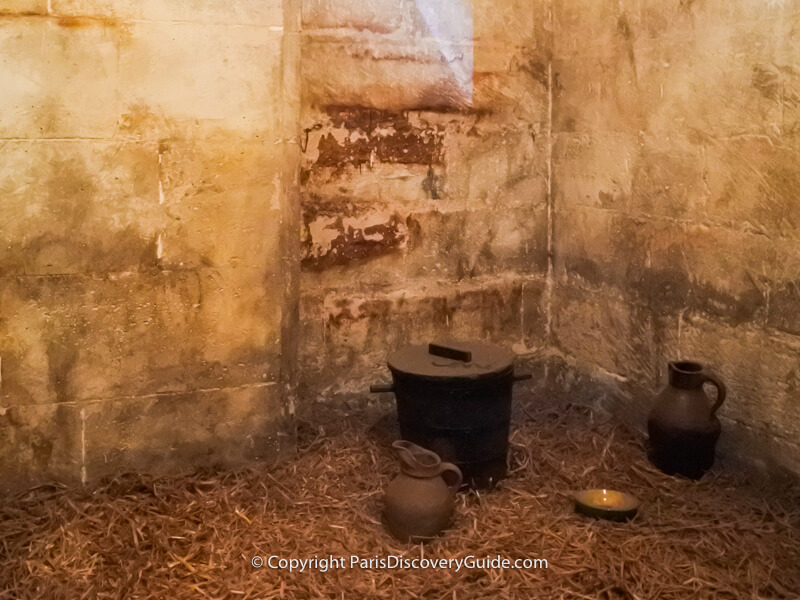
- Poor Prisoners' Cell - In prison as in real life in the 1700s, being poor condemned one to discomfort. You'll see the grim communal cells once packed with the poorest prisoners who slept on floors covered with a thin layer of straw. Needless to say, there were no bathrooms, no indoor plumbing. You may not want to imagine how it probably smelled.
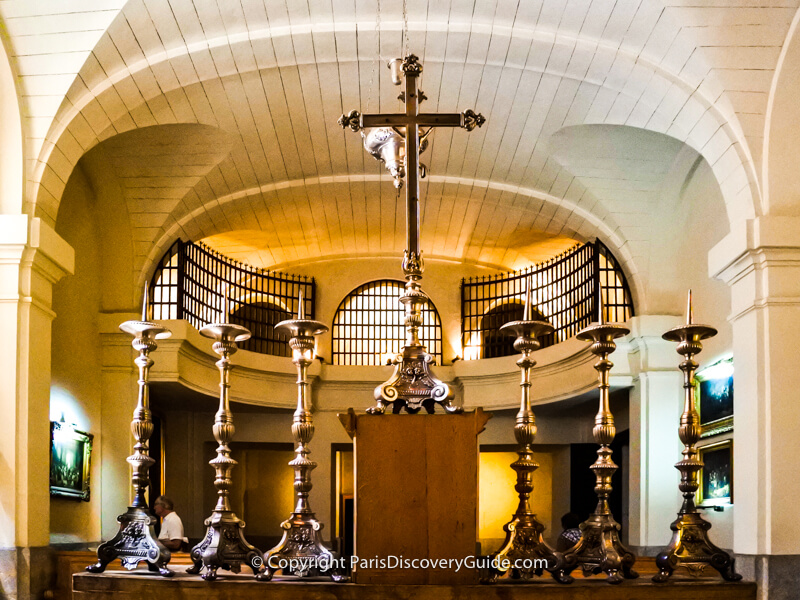
- The Girodins' Chapel - This chapel was created after a fire in 1776 destroyed the palace's medieval oratory on this location, and it is mostly unchanged from that time, although it was converted to prison cells during the Reign of Terror period. It gets its name from a Revolutionary group called the Girodins who were given a "last supper" of sorts here before being executed the next day.
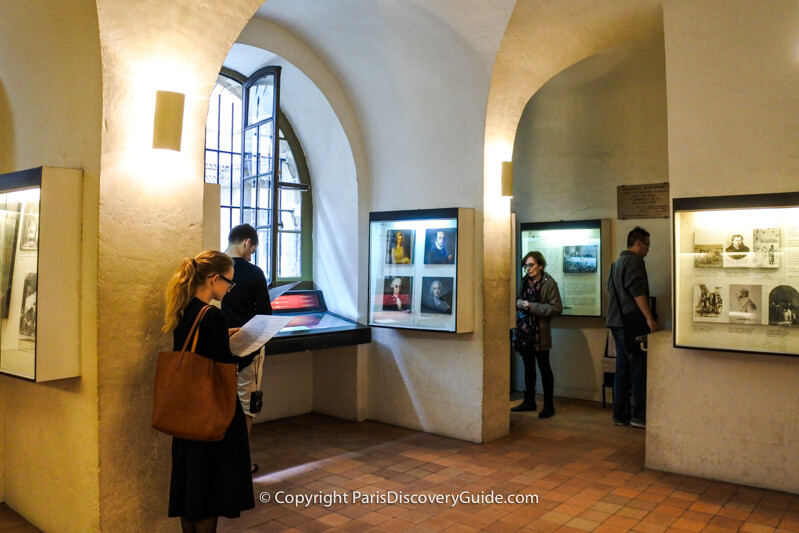
- Displays & Exhibits about the Conciergerie, Marie Antoinette, and other prominent prisoners - Although the content changes periodically, these exhibits are always well-curated and give you interesting insights about what the prisoners experienced here.
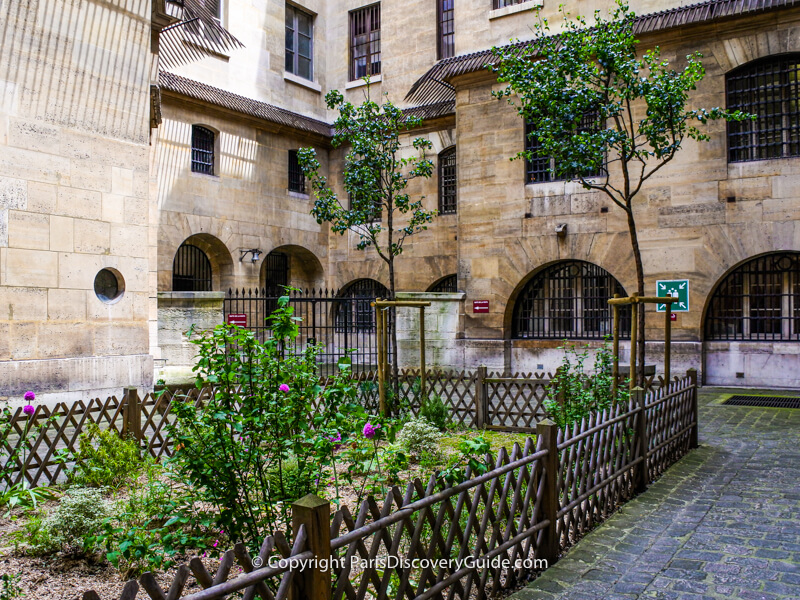
- The Women's Courtyard ( Cour des Femmes ) - Female prisoners were allowed to wash their clothes in the fountain here, walk around, and eat outside, although the flowers in the garden are most likely a present-day embellishment.
Get Your Conciergerie Tickets
Skip the line tickets.
Several ticket options are available for the Concergerie:
- Conciergerie ticket - Reserve your date and entry time on La Conciergerie's website
- Combined Skip-the-Line Tickets & Tour for Concergerie and Sainte-Chapelle - Great savings
- Île de la Cité Walking Tour including Notre Dame - On this small-group walking tour, your guide will give you a walking around the island and around the exterior of Notre Dame, plus you get skip-the-line tickets to Conciergerie and Saint-Chapelle
Although guided tours to Conciergerie are not available, detailed signs and the HistoPad give you all the information you need, even if you know next to nothing about Medieval life, the French Revolution, or Marie Antoinette.
Please note that free admission is available for all visitors under 18 (photo ID required) and EU/EEA visitors 18-25 (photo ID required).
Also please note that skip-the-line tickets let you bypass the ticket line, but not the security check, which can sometimes take a few minutes.
Get Free Entrance to the Conciergerie with a Paris Pass
Other options for skip-the-line entry: If you plan to visit other Paris museums and monuments, the Paris Museum Pass can save you a lot of money.
Not only does provide the Museum Pass give you free entry to the Conciergerie, but you can also use it for skip-the-line admission to 60+ other Paris attractions such as the Louvre, Versailles, and Arc de Triomphe. Choose a 2, 4, or 6 day pass.
Conciergerie Hours, Location, & Map
Open: Almost every day from January 2 through December 31 Closed: January 1, May 1, December 25
Schedule: 9:30 am - 6:00 pm Last admission is 30 minutes before closing
Location: 2 Boulevard du Palais, 1st arrondissement. The Conciergerie is located on the Île de la Cité near Sainte-Chapelle. Metro: Line 4, Cité or Saint Michel station RER: Line B or C, Saint-Michel station Bus: Lines 21, 24, 27, 38, 81, 85, 96 Batobus: (Notre Dame or Hotel de Ville stop) - Get Batobus hop on hop off river cruise tickets
Map Showing Concergerie Location
Know Before You Go
- For reduced mobility visitors: Conciergerie is not wheelchair accessible. There are 14 steps to enter the building, several sets of steps inside the building, and no adapted toilets.
10 Interesting Facts about the Conciergerie
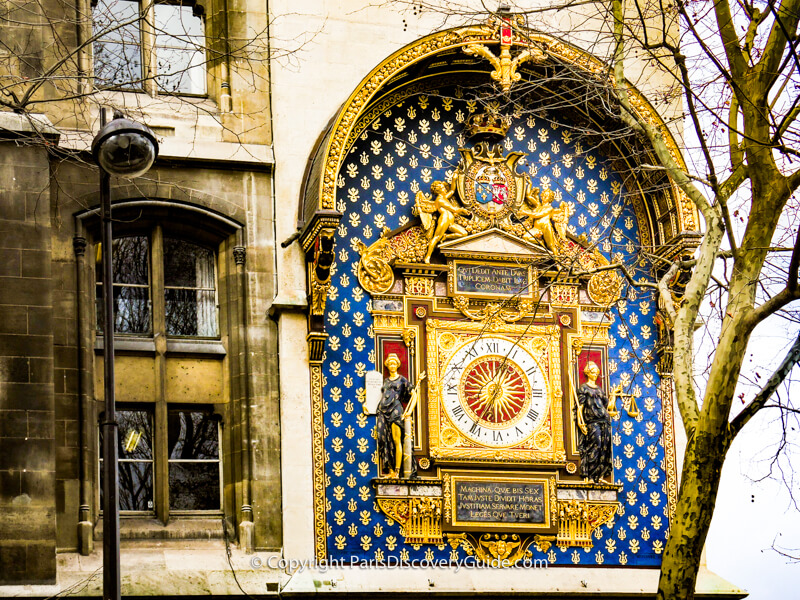
1. The first royal occupant of Palais de la Cité, part of which later became the Conciergerie, is believed to have been Clovis, the first King of France. The Palais de la Cité became the center of royal power in the 10th century when Hugh Capet, the first Capetian King of France, set up his government there.
2. The Conciergerie occupies the northern portion of a now-historic complex that includes another Medieval gem, Sainte Chapelle, renowned for its spectacular stained glass windows and the ornate Palais de Justice (Paris city courthouse).
3. However, most of the Conciergerie was built in the 1200s. It's the oldest remaining portion of the Palais de la Cité complex. Aside from the part of the Conciergerie open to the public to tour, law offices occupy most of the rest of the enormous building.
4. Do you notice how the Conciergerie's exterior looks like a medieval fortified castle? Of course, that's exactly what this former royal residence was long before it became a prison, but an early 19th century restoration spiffed up the sides of the building between the towers overlooking the Seine. However, the Conciergerie's three towers with cone-shaped roofs remain purely medieval: Caesar Tower and Silver Tower, where the kings' treasures were stored, date back to the early 1300s, and the oldest, Bonbec Tower, which was constructed between 1226 and 1270 and housed the Conciergerie's main torture chamber.
5. The late-medieval Clock Tower ( Tour de l'Horloge ) at the front of the building is the newest of the towers by a few years and dates back to around 1350 when it was built to be used as a lookout. In 1371, King Charles V installed France's first public clock in it. A makeover by King Henry III in 1585 gave the clock the beautiful façade you see today, with a gold leaf frame, sculpted allegorical figures representing Law and Justice, and golden fleur-de-lys against a royal blue background.
The clock still chimes every hour on the hour, and you can hear its mellow tones whenever you're in the neighborhood. The Latin inscription at the bottom of the clock says (in translation): "This machine which divides time into twelve perfectly equal hours helps you to protect justice and defend the law."
6. Why is the Conciergerie called the Conciergerie ? After an uprising of merchants against royal authority a few years earlier, King Charles V abandoned the palace in favor in 1364, converted it to judicial offices and prison cells, and appointed a concierge , a high-ranking official who served as caretaker to maintain order, oversee the police, and supervise the prison.
Eventually people started calling it Le Conciergerie . (This quick summary glosses over lots of interesting intrigue and drama involving the Hundred Years' War, power grabs and class warfare, tax increases, murder and mayhem, and even a bubonic plague pandemic. Sounds interesting? You'll want to read Barbara W. Tuchman's highly-rated A Distant Mirror: The Calamitous 14th Century which brings this era to life.)
7. By as early as the end of the 14th century, the Palace (aka Conciergerie) began to be used to incarcerate important prisoners ranging from royalty to robbers to would-be assassins and murderers, especially in cases where the torture chambers were useful for extracting confessions. It continued to serve as a prison until 1934.
8. Typically about 600 but as many as 1,200 prisoners occupied the Conciergerie at one time while awaiting their fate at the guillotine during the French Revolution's 10-month Reign of Terror, which began in September, 1793 and lasted until July, 1794 . All but about 100 of the 2,900 people judged by the Revolutionary Tribunal during that time were imprisoned there before being carted off to be executed, although over 40,000 French people died from execution and imprisonment during the Reign of Terror.
9. In addition to the French Queen Marie-Antoinette, other famous prisoners included Georges Danton, Madame du Barry, Robespierre, Charlotte Corday, and Madame Élisabeth. Later, during the 19th century, the future Napoleon III spent some time imprisoned there.
10. Although several courts (Court of Appeals, Criminal Court, Supreme Court) still occupy the historic Palais de Justice complex, most Paris judicial offices are now located in a new glass-clad Paris skyscraper designed by Renzo Piano next to Martin Luther King Park in the Batignolles neighborhood in the 17 arrondissement. The Conciergerie has been designated as a national historic monument since 1862, and open to the public for touring since 1914.
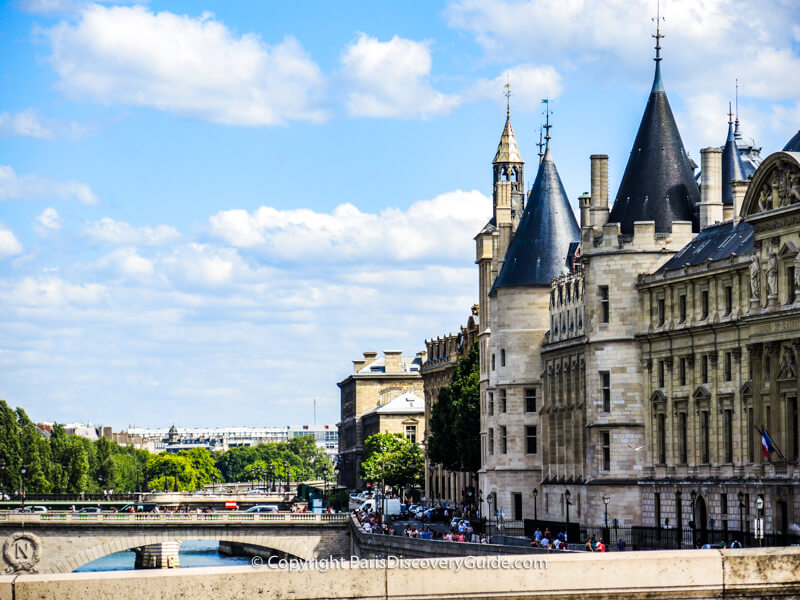
Where to Stay near the Conciergerie
Staying near the Conciergerie means you'll be in a perfect location for exploring the many historic attractions, beautiful parks, and excellent bistros and restaurants in this central part of Paris. These choices are all within a 5-minute walk, and range from surprisingly affordable (actually, downright cheap during non-peak travel seasons) to pricey and luxurious:
- Citadines Saint Germain des Prés - Serviced apartments (studios and larger) in a top-notch Right Bank location across from Île de la Cité and the Conciergerie Book best deals
- Relais Hôtel du Vieux Paris - Charming 4-star boutique hotel in a historic 15th century building in the Latin Quarter - just a quick walk across the Pont Saint-Michel bridge to the Conciergerie Find best rates
- Hôtel Left Bank Saint Germain - Charming 3-star boutique hotel with just 31 rooms in an 18th century building in fashionable Saint-Germain-des-Prés, just a 5 minute walk from Conciergerie - See best deals
Want more suggestions? Check out:
- Hotels near Notre Dame
- 1st Arrondissement Paris Hotels
- 6th Arrondissement Paris Hotels
Map Showing More Paris Hotels near the Conciergerie
Use this Paris hotel map to find more hotels and cheapest rates near the Conciergerie
Check out the newest Paris hotels
Where to Eat near Conciergerie
Les Deux Palais, almost directly across the street (Boulevard du Palais), is a popular place for well-prepared traditional brasserie fare: salads, steak-frites, pastas, or just a drink. The outdoor seating gives you great views of this lively corner of the neighborhood.
If you have more time, walk around the corner closest to the Seine and follow the road along the river to Place Dauphine (1 block away - find it on the map above). You'll see 8-10 small restaurants and cafes lining the square. Stroll around and read the posted menus to find what you like - all the choices are good.
Another wonderful nearby choice is Bistro des Augustins (39 Quai des Grands Augustins; find it on the map above), overlooking the Seine River. It's best known for its addictively good gratins, but its cheese and charcuterie platters are also outstanding.
All of these places are open for lunch and dinner.
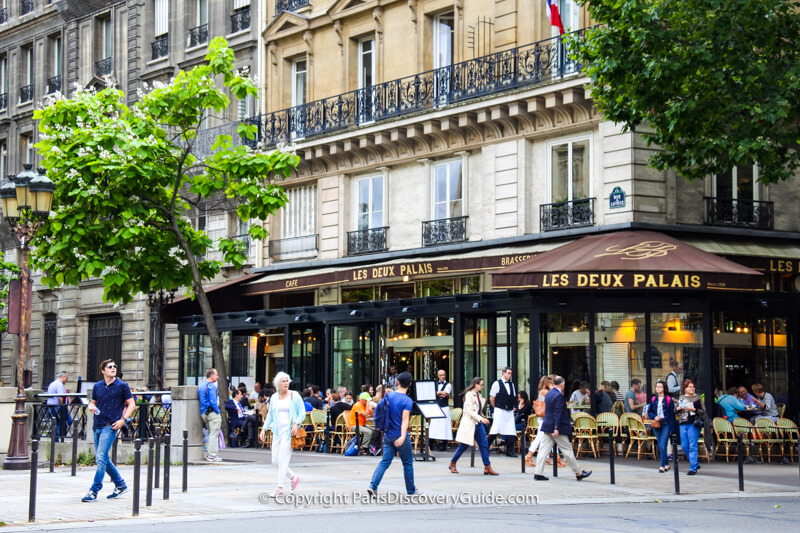
More to See Nearby: 2 More Medieval Masterpieces near Concergerie

Île de la Cité, the heart of historic Paris, is home to two more Gothic gems from dating back to the Middle Ages: Sainte Chapelle , a small but stunningly beautiful chapel within the same complex as the Conciergerie, and the famous Notre Dame Cathedral.
Many people visit Conciergerie and Sainte Chapelle on the same morning or afternoon since they are practically next door to each other. You can get a skip the line ticket (although you always have to pass through a security line), a discounted combo ticket for both sites, or join a guided tour including tickets to both attractions with an expert guide.
As you probably already know, a horrific fire ripped through the cathedral on April 15, 2019. An ambitious undertaking to repair the extensive damage and restore the cathedral by 2024 is underway.
If you want to learn more about the cathedral, see the restoration work (which is, truthfully, quite fascinating and impressive to watch), and explore other historic sites on the island, join the Île de la Cité Small Group Walking Tour, which includes skip-the-line tickets for the Conciergerie and Saint-Chapelle.

More to See & Do near Conciergerie
Pin now, read again later.

More Articles about Paris Attractions
- What to see & do at Sainte Chapelle - spectacular stained glass & classical music
- Find out about Île de la Cité's medieval masterpieces in the heart of Paris
- Paris Museum Pass - How much money and time can you save with it?
- How to get fast entry to top Paris attractions with skip-the-line tickets
- Easy day trips from Paris to Versailles, Giverny, Mont Saint Michel, D-Day Normandy Beaches, Disneyland, London, Bruges, & more
- How to get Eiffel Tower tickets without waiting in long lines
Top Attractions & Tours
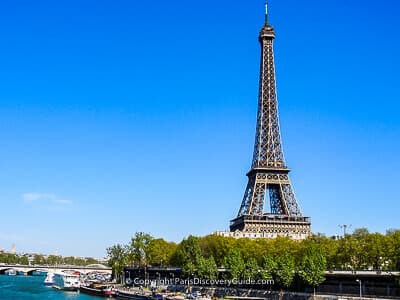
- Eiffel Tower - Enjoy sweeping views of Paris
- Louvre Tour - Soak up art & see the Mona Lisa
- Palace of Versailles - Best way to see the famous Chateau
- Paris Museum Pass - Choose 2, 4, or 6 days
- Paris Disneyland - Get express tickets & transport from Paris
Happening in Paris

January in Paris
- The famous Paris winter sales, concerts, new museum exhibits

February in Paris
- Valentine's Day, Chinese New Year Parades

March in Paris
- Mardi Gras, Fountain Shows at Versailles, French Open

April in Paris
- Paris Marathon, Easter concerts, spring flowers

May in Paris
- Mother's Day, jazz festival, concerts

June in Paris
- Summer sales, Pride week, music fests, air show

July in Paris
- Bastille Day, Tour de France, beaches

August in Paris
- Free concerts & movies, Rock En Seine

September in Paris
- European Heritage Days, Fashion Week

October in Paris
- Wine festival, Halloween, Motor Show

November in Paris
- Armistice Day, Salon du Chocolat

December in Paris
- Christmas, New Year's Eve

Hanukkuh in Paris
- Menorah lightings

Christmas in Paris
- Holiday celebrations & decorations

Christmas Markets
- Gifts, holiday food, mulled wine, and Santa
Newest Articles & Latest Updates

- How to Get to Disneyland Paris from Paris
- Best Palace of Versailles Tours from Paris
- 101 Famous Graves in Pere Lachaise Cemetery
- Where to Find Paris's Best Covered Passages
- Best Paris Food Tours
- Best Hotels with Free Shuttles to Disneyland Paris
Book Your Paris Hotel

Eiffel Tower Hotels
- See the Eiffel Tower from your balcony

Arc de Triomphe Hotels
- Great hotels with bargain rates

New Hotels in Paris
- Experience the latest & greatest

Paris Hotels near the Louvre
- Where to stay near the famous palace museum

Central Paris Hotels
- Wonderful hotels close to top Paris attractions

Deals & Discounts
- How to save on your Paris hotel
Plan Your Paris Trip
- Why visit Paris?
- Best Paris guide books
- Find cheap flights to Paris
- Choose your Paris hotel
- 7 Reasons why you need travel insurance
- Electric adapters and converters
- Best ways to get Euros
- Check out 10 top Paris attractions
- How to skip the ticket lines
- Paris Museum Pass: Should you get one?
- Which neighborhoods are best to stay in?
- What to do & see in each Paris district
- How to spend your first day in Paris
La Conciergerie in Paris: The Complete Guide
:max_bytes(150000):strip_icc():format(webp)/profilepic-CTraub-5b6ff65d46e0fb00505577c1.jpg)
Conciergerie
Consistently overlooked by tourists who beeline to the adjoining (and far more famous) Sainte-Chapelle, La Conciergerie is one of Paris' most enigmatic monuments. The impressive medieval palace complete with turrets and the remaining elements of a fortified wall looms over the Seine River , situated at the entrance to the "island" known as the Ile de la Cité. The centuries-old monument once served as a Gothic seat of royal power before being converted into a prison, revolutionary tribunal, chancellery, and seat of the French Parliament.
The Conciergerie served as a royal building from as early as the 6th century, during a time known as the Merovingian period and under the rule of King Clovis. In 1200, during the Capetian Dynasty, King Philip II made the Palais de la Cité (as the site was then known) the seat of royal power. It remained so until the 14th century.
Under Louis IX, a chapel was constructed, while during the reign of Philip IV, the palace was extended and renovated to incorporate administrative buildings. When the Louvre Palace was built during the 14th century, then-King Charles V abandoned the Palais de la Cité to take up residence in the Louvre. It was at that point that the Conciergerie was converted into a royal prison, chancellery and seat of Parliament.
During the French Revolution of 1789 and the period of "The Terror" (1993-1795), many political prisoners were held and tried at the Conciergerie. The ill-fated Queen Marie Antoinette had her cell here before her execution. Today, the Conciergerie continues to house a courthouse and tribunal, situated in the premises of the Palais de Justice.
How to Visit
The Conciergerie is open to visitors year-round, from 9:30 a.m. to 6:00 p.m. It closes on Jan. 1 (New Year's Day), May 1, and on Dec. 25 (Christmas Day).
Buying Tickets:
An individual ticket costs 18 euros, but there are discounts for groups and students. Many visitors opt to purchase a ticket that offers combined entry to the adjoining Sainte-Chapelle(a breathtaking, light-filled Gothic-era chapel noted for its elaborate stained glass and other decorative elements).
What to See
While only a relatively small part of the Conciergerie is open to the general public—the majority of its space is still dedicated to courthouses and administrative buildings—visiting the section that has been transformed into a museum is simply fascinating. Highlights include:
- The cell where Marie Antoinette was held during the final two months of her life in 1793, during the Reign of Terror. Here, curators have reconstructed the Queen's sparsely decorated bedroom to give visitors a sense of what her life as a prisoner may have been like; a robed figure represents the queen as a prisoner. The cell is also the site of an "Expiatory Chapel" built following the Revolution, following the Restoration period. It was meant to atone for the queen's execution and pays tribute to her and other royal figures executed during the Terror.
- Other cells and low-ceilinged dungeons where various other prisoners were held, as well as the former, tiny offices of prison wardens, complete with period furniture.
- A mural that shows the names of some individuals victimized by the Reign of Terror and imprisoned or tried at the Conciergerie. Their names are printed in different colors depending on their punishments, with those executed by guillotine shown in red. Other plaques and historical displays throughout the museum portion of the visit recount the history of the Revolution and the Reign of Terror, led by the infamous Robespierre.
- The Grande Salle (Great Hall) gives you a sense of the palatial dimensions of the structure and allows you to imagine its history as a gothic royal palace. On the lower level, La Salle des Gens D'Armes (Soldiers' Hall) is impressive at 210 feet long, with 28-foot ceilings. It once served as an enormous dining room for palace workers, as well as accommodating royal banquets and other formal occasions.
What to Do Nearby
Many big-ticket tourist attractions are in close reach of the Conciergerie, making it an ideal starting point for a tour of the area. Notre-Dame Cathedral (currently closed for renovations due to a devastating fire in 2019), the Latin Quarter , Shakespeare & Company bookshop, and the Shoah Memorial are among the other important sites that are easily accessible.
Also consider embarking on a Seine river sightseeing cruise or taking a self-guided tour of some of the most beautiful bridges in Paris . The Pont au Change affords breathtaking exterior perspectives of the Conciergerie, whether during the morning, at dusk or after dark.
The 10 Most Beautiful Bridges in Paris
Chateau de Vincennes: The Complete Guide
A Self-Guided Tour of Parisian Architecture
Visiting Sainte-Chapelle in Paris
Top 15 Monuments and Historic Sites in Paris
All About the Jardin des Tuileries in Paris
The Top 15 UNESCO World Heritage Sites in France
Paris' Pont Neuf: The Complete Guide
The 8 Most Beautiful Squares in Paris
9 Places for Jewish History in Paris, From Museums to Memorials
Versailles Palace and Gardens: The Complete Guide
Top 15 Things to Do at Night in Paris
The 12 Best Day Trips From Paris
The Top 12 Things to Do Around the Eiffel Tower
A Guide to the 4th Arrondissement in Paris
The Top 10 Things to Do in Paris's Saint-Germain-des-Prés District
Conciergerie
The Single Gothic Castle of Paris
People around the world clamor to visit the Gothic masterpieces of Paris. They think of names like Notre-Dame and Sainte-Chapelle. But there is one (and only one) civil monument in the city that survives in the Gothic style. We are, of course, talking about the Conciergerie.

This fortress was the backdrop to many important moments in French history, and today it remains a potent reminder of life in the Middle Ages. And since its construction, it has continued to play a pivotal role, seeing some of the most important moments in the French Revolution — making this monument one of the most storied in all of Europe.
Thanks to valiant efforts of restoration and maintenance, you can visit the Conciergerie and see what life was like in an earlier time.

Going to Conciergerie with a guide?
And if you are going to go to the Conciergerie on your next trip to Paris, you should do it with a cerified local and knowledgeable guide! With my team, you can:
Learn the secrets of the Gothic architects as you walk inside the halls they designed.
Hear live explanations about every detail you see — and you can ask as many questions as you’d like!
See how people used to live and eat in Medieval times.
Get to know the best stories from the royal families from a time of castles and knights.
Listen to stories about the thrilling and dangerous French Revolution.
Relive the last moments of Marie Antoinette — you can even visit her jail cell.
Ask your tour guide any questions about Gothic architecture, French history, and Parisian monuments!

Pair your tour
Conciergerie with sainte-chapelle guided tour.
If you really want to experience the Gothic side of the City of Lights, pair your visit to the Conciergerie with a tour of the mesmerizing and beautiful Sainte Chapelle — located just next door. This is the ultimate exploration of Gothic France.
A guided tour of the Conciergerie is a one-of-a-kind way to see the Middle Ages on your next trip to Paris!
Are you interested in the history of Gothic architecture in Paris? Read more to learn about the Conciergerie, Gothic architecture, how the French Revolution used this castle for its own purposes, and what you can expect when you visit.
History of the Conciergerie
The Conciergerie stands on the Île de la Cité, an island in the middle of the Seine river that cuts through Paris, France.
This island is also home to a number of other Gothic masterpieces — most notably Notre-Dame and Sainte-Chapelle. That’s because it has been associated with power for almost 2000 years.
It was first used to house the fortress of Roman governors. And when the Franks took over after the Empire fell, King Clovis I built his palace there in the 6th century. For generations afterward, many kings continued to add their own projects to this island. They added new palaces, grand cathedrals, and other impressive structures. Situated away from the core of Paris itself, it was easy to defend, and it boasted a long history of prominent residents. Though the Franks moved their capital away from Paris for a handful of centuries, it returned to Paris under the rule of Hugh Capet in the final years of the 10th century.
Where did he build his palace? On the Île de la Cité.
He continued to build on this royal area (which was coming to be called the Palais de la Cité). Capet launched France into a massive construction campaign, an undertaking that eventually kicked off the French Gothic style. This major shift in architecture pointed towards an exciting new form of building that stepped away from the Romanesque and into an era-defining look that we still marvel at today.

What Is Gothic Architecture?
To understand the Conciergerie, we need to understand what makes Gothic architecture so special. For the French Gothic (a style that dominated from the middle of the 12th century to the middle of the 16th), a few key things stand out.
The first and foremost is a push for verticality. That means making this very tall and placing visually interesting features high above. This was especially true in religious buildings, the idea being to raise people’s attention up towards heaven. It also allowed for many more windows, which let in more light.
But to make buildings taller than had ever been dared before, you needed new engineering solutions. The problem was that these solutions couldn’t just serve the practical purpose of supporting tall spires — they needed to look beautiful at the same time.
One of the most important ways architects were able to achieve this height was with flying buttresses. These are features on the outside of buildings that lend support. That allows walls to be thinner and rise much higher, as the buttresses push them in and keep them from collapsing. While on the inside this leads to buildings appearing to defy the laws of gravity, on the outside it adds attractive visual interest.
Rib vault ceilings are also a tell-tale sign of Gothic architecture. These have exposed supports in the ceiling, giving handsome details. Again, this method allowed for ceilings to be higher.
These two iconic features, along with many others, made buildings of the time significantly taller than any before in Europe. And with that height came kaleidoscopic stained glass designs in royal blues, reds, and purples.
Added together, the Gothic style proved to be a lasting shift in the look of buildings as well as the way they were engineered. And while the most famous examples of the French Gothic are religious, the Conciergerie was not.

After the Kings
It was Chales V, ruling in the second half of the 14th century, that took the royal residence to the Louvre Palace — a move that would forever split the French monarchy from the Île de la Cité. Nevertheless, the area continued to be an important site of administrative activity.
And the Conciergerie still played an important role as a place for the courts and, eventually, prison cells. In fact, this use of the building would prove to be one of its most important over the course of the following centuries.

The Palais de la Cité and the Conciergerie
This palace was a sprawling complex of buildings that continued under construction (in some form or another) into the 20th century. That might sound strange — a royal site that was continually built and rebuilt for over a thousand years. But as new situations arose, kings had different uses they needed out of the land.
Even when kings left Paris altogether, they still made use of the island in the middle of the city.
Their projects were not only governmental in nature. They often also sought to add prestige to the crown through religion.
For instance, in 1163, Notre-Dame began construction. This proved to be an important building for Roman Catholicism, as well as a shining example of what the French Gothic style could do. Today, it is probably the single most recognizable cathedral in the entire world.

A little less than 100 years later, King Louis built the astounding Sainte-Chapelle right off of his palace. This further cemented the island as the epicenter of the French Gothic.
But the Palais de la Cité was in great need of plenty of secular buildings, too. After all, this was supposed to be the beating heart of the government.
That’s why the judicial complex of the Conciergerie was constructed in the early 14th century on the island.

Why the Name Conciergerie ?
The building got its name thanks to Philip II. He was planning to leave France with a group of soldiers to fight in the Crusades, and so he temporarily handed over his local authority to the Curia Regis (Latin for royal council) and relocated the royal archives to this building. He gave the overlooker of the palace the title of Concierge — and thus the building itself was named the Conciergerie.

The Prison of the Conciergerie
The conditions of imprisonment at the Conciergerie varied widely. Among the elite, a stay might not be so bad. After all, you would have reading material, visitors, and a bed — as long as you had the money to rent them. It might not be as nice as the luxurious hôtels you were used to, but one could manage for a short sentence.
Poorer people, however, were not so lucky.
Below the aristocratic level of accommodation, you might have a small bed and maybe a table. These weren’t so expensive. But things could get a lot worse for the poor.
There were other cells. Darker cells. Places of unbelievable inhumanity. These were called oubliette — a word meaning forgotten place. But for the people imprisoned there, they were unable to forget just how dreadful it was. These cells enjoyed little to no light, and they dripped with odd water that gathered in puddles on the earthen floor. Rats scurried everywhere, carrying fleas that brought plague and every other imaginable illness.
It was a terrible place to be locked up, and many did not survive the cruel conditions.

Leading to the French Revolution
The 15th through to the 18th centuries saw more or less constant adjustments to the building and its surroundings, as well as major rebuilding efforts. Floods, fires, and similar catastrophes required repairs that allowed for major changes to take place.
While styles had certainly changed since its construction, the Conciergerie luckily retained its famous look, and all the while it served as a center for lawmaking and law enforcement.
It is that high profile and central role that would prove to be critical during the French Revolution.

The Conciergerie in the French Revolution
There are few places in Paris that are as important to the story of the French Revolution as the Conciergerie. It is here that the Parliament of Paris first resisted the King. It is here that the Constituent Assembly first took over legislative power.
During those years, the prisons swelled with enemies of the Revolution. These prisoners were later killed in the September Massacres, a crime that included the mass murder of 1300 people.
It was also here that the Revolution found its most famous prisoner: Queen Marie-Antoinette.
She was brought in on August 3, 1792, first residing at Temple Prison. But when her husband King Louis XVI was executed, she was moved to the Conciergerie. While in years past, a woman of such stature would have been given the finest accommodations the prison could muster, the revolutionaries had a different approach to royalty. They gave her a simple bed and room with a window.
But this proved untenable. Though she was under constant supervision, several rescue missions came to light, and she was brought into a different cell that could be even more heavily guarded. It is there that she stayed just over six weeks.
When you visit the Conciergerie today, you can see this cell. While the grand palace at Versaille or the tremendous collection at the Louvre tell us so much about French history, you can also come to this quiet, modest space and feel the story of a country and its people coursing through you. In fact, you can almost hear Marie whispering her final prayers on October 16, 1793, just before she was carted away to the guillotine set up in the Place de la Revolution.
The Conciergerie also saw the trials of Danton and other revolutionary leaders as the Reign of Terror began to set its sights on its own. This reached its tragic and, perhaps, most ironic height when none other than Robespierre was arrested by moderate revolutionaries who were afraid to let the Revolution go any further.
With an air of poetry, they jailed Robespierre in the same cell as Marie Antoinette.

The Conciergerie After the Revolution
Though France had fewer trials and prisoners when the Revolution ended, the building proved useful still. And with the Bourbon Restoration, the rise of Napoleon III, the July Revolution, the Revolution of 1848, and the Paris Commune, there was plenty of upheaval to keep things interesting on the Île de la Cité.
But over the 19th century, the perspective on the building changed. Restoration efforts led by A.M. Peyrle enshrined the building as a memorial and monument. And new civic buildings on the Île de la Cité and around Paris gradually took over the roles that the Conciergerie once played.
In 1934, the prison of the Conciergerie finally closed, and over the 20th century, the building gradually became a place of interest for our guests.

The Conciergerie Building
History aside, the Conciergerie remains a beautiful building. The sophistication of its architecture is simply breathtaking, allowing for quiet moments of awe that seem oddly transcendent for a building meant to house the prosaic activities of government.
The exterior has tremendous rhythm and verve, with the white stone capped off with its trademark dark blue roof. Everything comes together with the clock tower, a yellow and blue masterpiece of 14th century design. Inside, it continues to astound. The rib vault ceilings, spiral stairways, and masonry are elevated features that show how the Middle Ages were anything but “dark.”

Hall of the Men-at-Arms
Built in the early 14th century, the Hall of the Men-at-Arms is enormous, with ceilings almost 9 meters high, and it is the largest secular Gothic hall in all of Europe. Visiting it always sends people’s jaws to the floor. The columns that reach up to the vaulted ceilings are dramatic. This is architectural history in all its majesty!

Hall of the Guards
This feature was built under the authority of Philip IV, the same king who authorized the Hall of the Men-at-Arms. This area was first used for the Royal Guard, then later as an antechamber for the Parliament that met in the room above it. And after this, it was turned into a dungeon, a tradition that the French Revolution made particular use of.

Because it is a building of such historical importance, the Conciergerie is now home to many memorials.
One of the most popular is the Hall of Names. This is an exhibit that displays the names of each person that the Revolutionary Tribunal sentenced to execution. With over four thousand, it is a stark reminder of this bloody chapter in history.
There is also a memorial to Marie Antoinette, designed by A.M. Peyrle and completed at the same time as his renovations to the Conciergerie.
Alongside these are numerous exhibits that show artifacts from the long history of the building. The exhibits also present examples of prison cells and the tools of the prison guards.
These are great features for any visit to the Conciergerie, helping to highlight the history contained in this building with informative displays that visitors always enjoy.

Recent Exhibit The Sleeping Chapter by Théo Mercier
Beginning October 14, 2022 and running to January 8, 2023, this exhibition featured sculptures made out of sand populating the Hall of the Men-at-Arms.
Théo Mercier’s installation is the third of a triptych of such works that all fall under his OUTREMONDE project. This ambitious artistic journey concluded at the Conciergerie with fascinating sculptures that take us into the collective world of dreams.
Because these works are crafted out of sand, they match the pale stone work all around. In that way, they seem to have come together from the building itself, like they are ghosts that refer to some memory held in the ancient Conciergerie.
Being made out of sand, they are also impossibly fragile. These works cannot be relocated without destroying them. Just like our own dreams, they appear so real and permanent yet can disappear in an instant.
The overall effect of walking through the space with these sculptures was a blessing. It brought new life into the Conciergerie, with Mercier filling the hall with physical embodiments of dream images from the city itself. It felt like time collapsed, with contemporary artists living alongside Gothic stone masons, if only for a few months.
How did Mercier do it?
The pieces were sculpted on site , using sand and water to form the shapes and hold them. Sometimes the artist allowed them to drift off, with parts of the sculptures spilling out. But with others, their borders were carefully maintained, looking almost like they were chiseled out of rock.
The fragility of these pieces provides an interesting counterbalance to the longevity of the Conciergerie itself. Visitors held at their feet these transient works whose medium was chosen so that they wouldn’t last. Yet all around were columns and floors and vaulted ceilings that have lasted for centuries and will continue to last for centuries more.
Bringing in art exhibits to the Conciergerie might at first seem an odd idea, but when you experience it, it all makes sense. It breathes such vitality into the space, allowing you to see it as a living work and not simply a fossil from some former time.
On your visit to Paris and the Conciergerie, who knows what exhibit they will have on offer?

Visit to the Conciergerie with a knowledgeable Private tour guide Flora
Direct Email : [email protected]

Do you want to visit this Gothic castle with a knowledgeable local guide?
There is no monument quite like the Conciergerie, so if you want to start planning your guided tour, send me an email and I will help you with the booking. I can bring the rich and long history of this architectural marvel to life.
My knowledge and expertise mean that you can get the most out of your tour, learning all about the fascinating characters that walked these halls and the moments in history that threatened to shake the building to its foundation!
From Our Blog

History of Paris Cuisine at the Conciergerie

Marie Antoinette from Versailles to Conciergerie

The Conciergerie in Paris
Nestled on the Île de la Cité, in the heart of the 1 st arrondissement of Paris, the Conciergerie is a former royal palace turned prison. With its impressive gothic architecture and long history, it most definitely is worth a visit!
Follow the guide!
⚠️ The Sainte-Chapelle is a victim of its own success , especially during peak season. T o avoid wasting time , be sure to book your skip-the-line tickets in advance.
💡 The Captain’s tips 💡
🧐 Keen to delve into Paris’ rich history? Captain Ulysses suggests checking out this complimentary guided tour of the city . You decide how much to tip the guide!
💤 Searching for the perfect stay in Paris? Take a peek at Captain’s picks for the best places to stay: Where to stay in Paris? Tips & Recommendations.
👶 Planning a family adventure to Paris? Discover all of the Captain’s top tips in the article: Exploring Paris with the Kids: Family-Friendly Activities
Brief history of the Conciergerie in Paris
The origins of the conciergerie.
While the Île de la Cité has been the Parisian residence of kings since the early Middle Ages, the palace as we know it today was built during the reign of Philip IV of France (aka Philippe Le Bel / in English Philip the Fair) between the 13 th and 14 th centuries.
Built in a resolutely Gothic style, this vast royal palace embodied the power and sovereignty of the kings of France.
In the late 14 th century, Charles V and later his successors abandoned the Palais de la Cité to take up residence in the Louvre and Vincennes. However, the services of the royal administration remained on the Île de la Cité.
🤔 Where does the name of the Conciergerie come from? 🤔
The Conciergerie owes its name to the Concierge, whp was the governor of the King’s Household at the time when the Palais de la Cité was a royal residence. When the Conciergerie became a prison, the Concierge became its director.
The Conciergerie, from royal palace to prison
In the late 14 th century, part of the Conciergerie was converted into a prison to serve as an annex to the neighboring Châtelet prison.
Over time, the Conciergerie became a full-fledged state prison, as well as the nerve center of the judicial activity of the French capital.
On the eve of the Revolution, the Palais de la Cité housed the Chambre des Comptes (audit chamber), the Cour des Monnaies (court of currencies), the Cour des Aides (court of aids) as well as the Parisian Parliament.

The Conciergerie during the French Revolution
At the end of the 18 th century, the Conciergerie became the symbol of all that was destructive and bloody about the French Revolution.
The Conciergerie was a detention facility, and from 1792 onwards it housed the Revolutionary Tribunal, where “enemies of the people” were brought to justice before those judged guilty were executed. Hence its sordid nickname of “antechamber of the guillotine”.
Many famous historical figures appeared before the Revolutionary Court and were incarcerated in the Conciergerie prisons, such as Marie-Antoinette, Charlotte Corday, Philippe d’Orléans, Antoine Lavoisier, and even Robespierre, who in 1794 went from accuser to accused.
In 1794-95, the French, fed up with the violent excesses of some revolutionaries, demanded an end to this bloody era known as the “the (Reign of) Terror”. The Revolutionary Court was abolished on May 31, 1795, three years after its creation.
In the following years, the Palais de la Cité became the Palais de Justice de Paris (Courthouse).
The Conciergerie today
The Conciergerie ceased to be a prison in 1914. Listed as a Unesco World Heritage Site, it is now a national monument open to the public, as is the neighboring Sainte-Chapelle.
Visiting the Conciergerie in Paris
The Conciergerie now invites visitors to dive into the long history of the French capital. While visiting the Conciergerie, Captain Ulysses recommends opting for the Histopad, a touch-screen tablet on which you’ll be able to discover a reconstruction of the Palace by means of augmented reality.
The exterior of the Conciergerie
Before entering the Conciergerie, take some time to admire the impressive gothic building from the outside.
The Clock Tower, visible from the Boulevard du Palais, is undeniably an architectural gem. To enjoy a panoramic view of the Conciergerie, Captain Ulysses recommends crossing the Seine on the Pont au Change.
The Salle des Gens d’Armes & the Salle des Gardes
Built during the reign of Philippe Le Bel (1268-1314), the Salle des Gens d’Armes is a stunning vaulted room whose gothic architecture is sure to delight art and history lovers. It regularly hosts temporary art installations.
Built around the same time, the Salle des Gardes housed at the end of the 18 th century the infamous Revolutionary Court.
Medieval kitchens
Overlooking the Salle des Gens d’Armes, the medieval kitchens were built during the reign of Jean Le Bon (1350-1364).

The revolutionary rooms
Spread out between the first floor and the 2 nd floor, the revolutionary rooms retrace through exhibitions and historical reconstructions the role played by the Conciergerie during the French Revolution.
Terror, Revolutionary Court and Dictature du Salut Public (=Dictatorship of Public Safety) will no longer hold any secrets for you.
The prisoners’ chapel is located on the former site of the king’s oratory. During the Revolution, the chapel was transformed into a collective prison.

The expiatory chapel of Marie-Antoinette
Built during the Restoration – the period of French history during which the House of Bourbon returned to power – on the initiative of King Louis XVI, the expiatory chapel of Marie-Antoinette pays tribute to the fallen queen.
The court of women
This inner courtyard was once used as an outdoor space where women prisoners could go for a walk in the Conciergerie.
Getting to the Conciergerie
The Conciergerie is nestled on the Île de la Cité, within the precincts of the Palais de la Cité, a stone’s throw from the Sainte-Chapelle , the Marché aux fleurs and Notre-Dame-de-Paris.
The nearest metro station is Cité, on metro line 4 (if you’re not in great physical shape, take the elevator to get back to the surface!)
The Saint-Michel station (line 4 and RER C, connected to the Cluny – La Sorbonne station where you will find line 10 and the RER B) is also located a few steps from the Conciergerie. You can also stop at the Châtelet station (lines 1, 4, 7, 11 and 14).
City buses (lines 21, 24, 27, 38, 58, 81, 85, 96) as well as sightseeing bus tours also stop near the Conciergerie.
Opening times
The Conciergerie is open every day of the week from 9:30 am to 6 pm. The ticket office closes at 5:15 pm.
The Conciergerie is closed on May 1 st and December 25th.
Admission rates
The full price ticket for the Conciergerie is €11.50. If you also plan to visit the Sainte-Chapelle, then it is much more cost-effective to opt for the combined Conciergerie + Sainte-Chapelle ticket at the price of €18.50 (compared to €23 separately).
Be warned, the Conciergerie and the Sainte-Chapelle are victims of their own success. To avoid wasting precious time in line, Captain Ulysses strongly recommends that you book your tickets online in advance:
👉 Entrance ticket for the Conciergerie (+ Sainte Chapelle)
💡 The Captain’s tip: access to the Musée de l’Orangerie is also included in the Museum Pass, It provides direct access to more than 60 museums and monuments in Paris, including the Louvre Museum, the Musée d’Orsay and the Centre Pompidou. More information: Paris Museum Pass
👉 Skip the lines: book your tickets and tours in advance!
👉 looking for a place to stay in paris, 👉 looking for advice and recommendations here are all of captain ulysses’ suggestions.
🛏️ Accommodation : Booking . For all the Captain’s advice and recommendations: Where to stay in Paris?
🎟️ Activities: GetYourGuide | Civitatis
⛵ Cruises: Seine River Cruises
🎫 Citypass: Paris Museum Pass
🚐 Transfers: Transfer to/from your hotel
🚌 Local Transportation: Hop-on Hop-off Bus | Batobus
✈️ Flights, Trains & Buses: Skyscanner
How useful was this post?
Click on a star to rate it!
Average rating 0 / 5. Vote count: 0
No votes so far! Be the first to rate this post.
As you found this post useful...
Follow us on social media!
Related posts

Shakespeare’s Globe in London

Street Art In The 13th Arrondissement Of Paris

Where to eat in Bruges? The Captain’s top recommendations
Leave a reply cancel reply.
Your email address will not be published. Required fields are marked *
Save my name, email, and website in this browser for the next time I comment.
Privacy Overview

Conciergerie – what to expect, tickets, prices, timings, FAQs

Perched on the Île de la Cité, a small island on the Seine River in the heart of Paris, lies the Conciergerie, a historical gem that has witnessed centuries of intrigue, despair, and transformation.
With its imposing medieval architecture and rich history, the former royal palace turned prison is a testament to the city’s enduring past and has played a significant role in shaping the narrative of France.
This article covers everything you must know before booking tickets for the Conciergerie Paris.
Top Conciergerie Tickets
# Conciergerie # Sainte Chapelle et Conciergerie
# Notre-Dame Island, Sainte-Chapelle et Conciergerie: Guided Tour
Table of contents
What to expect at conciergerie, where to book tickets, how do online tickets work, conciergerie ticket prices, discount tickets , conciergerie tickets, tickets for sainte chapelle and conciergerie, tickets for guided tour of notre-dame island, sainte-chapelle and conciergerie, how to reach conciergerie, opening hours of conciergerie, how long does the tour take, best time to visit conciergerie, faqs about the conciergerie.
The Conciergerie is a national monument and museum originally built as a fortress in the 10th century, later becoming a grand residence for French kings.
Learn about the building’s transition from an opulent palace to a symbol of oppression and ultimate judgment, encapsulating the turbulent times that Paris and the nation experienced during the late 18th century.
Get insights into how 2,780 prisoners, including Marie-Antoinette , were detained, imprisoned, tried, and sentenced at the Conciergerie before facing execution by the guillotine during the French Revolution .
Be transported back in time to witness the somber ambiance that once pervaded its halls.
The architecture of the Conciergerie tells a story with its striking Gothic arches, stone vaults, and intricate details.
Stand in the Salle des Gens d’Armes, the largest room within the complex, with impressive towering pillars and vast space, serving as a reminder of the palace’s grandeur in its heyday.
Contemplate the anguish endured by the prisoners and the justice system of the time by visiting Rue de Paris in the Conciergerie.
Look at the recreated scenes, multimedia exhibits, and informative displays offer a glimpse into the prisoners’ daily lives.
Pay your respects to one of the most poignant sections of the Conciergerie, the Chapel of the Girondins, a place of worship transformed into a memorial for the victims of the Revolution.
The Conciergerie also houses the Palais de Justice, the current seat of the French judicial system creating a fascinating juxtaposition of the past and present within the same premises.
Back to Top
Tickets for the Conciergerie Paris are available online in advance or at the attraction.
Online ticket prices tend to be cheaper than tickets at the venue.
When you buy online, you can avoid the long queues at the attraction’s ticket counters.
When you book early, you also get your preferred time slot.
Because some attractions sell a limited number of tickets, during peak days they may sell out. Booking early helps avoid last-minute disappointments.
Go to the Conciergerie ticket booking page , and select your preferred date, time slot, and number of tickets to buy the tickets.
Once you purchase Conciergerie tickets, they get delivered to your email address.
There is no need to get printouts of the ticket.
You can show the e-ticket on your smartphone when you visit the attraction.
Save time & money! Buy Paris Museum Pass and visit over 60 famous attractions in and around Paris. Book now and explore museums and monuments such as the Louvre and Versailles.
The Conciergerie prison tickets are priced at €13 for all adults aged over 18 years of age.
Visiting the monument is free on European Heritage Days (the third weekend of September) and on the first Sunday of the month, from January 1 to March 31 and from November 1 to December 31.
Tickets for guests under 18 years, EU residents under 26, school teachers with a pass, disabled visitors and their carers, and French job-seekers are free.
It is mandatory to present a valid ID proof and book a timeslot of visit in advance, without which entry to the monument will be refused.

A ticket to the Conciergerie gives you entry to the monument, a powerful symbol of France’s resilience, endurance, and complex past and evolution.
You will also get a Histopad, an interactive digital tablet device offering augmented reality experiences to enhance visitors’ understanding and engagement with historical sites.
With your Histopad available in six languages, you will create virtual reconstructions and visualizations of the historical prison in an immersive and interactive way.
Ticket Prices
Adult Ticket (18+ years): €13 Child Ticket (up to 18 years): Free

A ticket to the UNESCO World Heritage site Sainte Chapelle and the Conciergerie gives you entry to France’s two popular tourist attractions.
Your ticket allows you a thirty-minute valid time slot for entry and a Histopad to make the most of your tour.
Visit the pristine Sainte Chapelle, one of the finest architectural wonders of the world since its consecration on April 26, 1248, and then make your way to the Conciergerie.
Children under 18 years must be accompanied by an adult for this tour, however, this is not applicable for school groups.
The visit is free for EU citizens under 25 and non-Europeans residing in France.
Ticket Cost: €20

A Notre-Dame Island, Sainte-Chapelle and Conciergerie pass gives you guided access to the Notre Dame Cathedral, an iconic masterpiece in the heart of Paris that has captured the imagination and reverence of millions of people worldwide.
Heal yourself at this spiritual haven and be fascinated by the awe-inspiring Gothic architecture, rich historical significance, and enduring cultural legacy.
Learn all about the landmark historical events of the Cathedral including the coronations of French kings and the beatification of Joan of Arc.
Adult Ticket (18+ years) : €60 Child Ticket (4 to 17 years) : €60 Kids Ticket (up to 4 years) : Free
The Conciergerie is located in Île de la Cité, Paris.
Address: 2 Boulevard du Palais, 75001, Paris. Get Directions
The Conciergerie can be easily reached by public transport or car.
Take bus lines 21, 38, 47, 58, 70, 75, or 96 to Cité bus stop.
The nearest station to the Conciergerie is Cité station , serviceable by line 4 and is a one-minute walk from the monument.
Other nearby stations are Châtelet station and Saint-Michel station , serviceable by lines 1, 7, 11, and 14, and lines B and C, respectively.
Châtelet station is a four-minute walk, and Saint-Michel station is a two-minute walk from the Conciergerie.
If you’re driving by car, turn on Google Maps and get started.
There are a few car parking garages where you can park your vehicle.
The Conciergerie Paris opens every day from 9.30 am to 6 pm.
The last access to the monument is until 5.30 pm, while for the exhibition “Paris, capital of gastronomy, from the Middle Ages to the present day” it is 5 pm.
Nocturne on Saturday evenings lasts until 8 pm, with the final admission at 7 pm.
The Conciergerie is closed on May 1 and December 25.
Histopad tablets are delivered until 4.30 pm.
The Conciergerie tour takes approximately 45 minutes to one and a half hours on average.
The duration may differ based on many factors, like the number of visitors, off-peak or peak season, and so on.
The best time to visit Conciergerie is when it opens at 9.30 am.
During the early morning, the monument sees minimal foot traffic, allowing you ample time and space to leisurely explore every corner at your own pace.
The monument is more crowded on European Heritage Days (the third weekend of September) and the first Sunday of the month, from 1 January to 31 March and from 1 November to 31 December, because of free entry.
Try visiting the attraction on weekdays rather than weekends, preferably in the morning or afternoon, for a quieter experience.
Here are some questions visitors usually ask before visiting the Conciergerie Paris.
The last admission time in the Conciergerie is 45 minutes before the closing time.
No, there is no baggage deposit or locker facility at the Conciergerie. For this reason, big bags and suitcases aren’t allowed inside the monument.
Yes, special rates for groups of twenty members are available at the site.
Yes, you can donate to the Conciergerie as your donations contribute to the monument’s development, conservation, and attractiveness.
Sources # Paris-conciergerie.fr # Wikipedia.org # Tripadvisor.com The travel specialists at TheBetterVacation.com use only high-quality sources while researching & writing their articles. We make every attempt to keep our content current, reliable and trustworthy .
Popular attractions in Paris
How useful was this post?
Click on a star to rate it!
Check out all the things to do in Paris
This article was researched & written by
Vanshita Raj
Vanshita sees travel as more than a hobby—it’s her way of expressing herself. She loves road trips, taking spontaneous detours to explore captivating landscapes and immerse herself in new cultures. Vanshita enjoys collecting souvenirs that hold the essence of the places she visits and capturing moments in photos that tell a story. Whether it’s the historic charm of Boston, the vibrant streets of Budapest, or the serene beauty of Nikko, each city holds a special place in her heart. She loves to inspire everyone with her unique stories of adventure. Favorite travel movie: The Holiday. Next destination: California
Edited by Rekha Rajan & fact checked by Jamshed V Rajan
Leave a Comment Cancel reply
Save my name, email, and website in this browser for the next time I comment.
FireStorm Internet runs this website to provide the most accurate and up-to-day information about tourist attractions.
Our Address
FireStorm Internet, 203, 30C, Bollineni Hillside, Perumbakkam Main Road, Nookampalayam, Chennai, India. Pin Code: 600126
About Us The Team Contact Us Affiliate Disclaimer Content Policy HTML Sitemap Privacy Policy Terms of Service
Helicopter Tours Food Tours Ghost Tours Stadium Tours Hop On Hop Off Tours Zoo Tickets Madame Tussauds Linq High Roller Summit One Vanderbilt
© 2024 FireStorm Internet

Conciergerie palace guided tour
Discover the oldest Royal palace in Paris, converted into a prison in the 15th century and nowadays housing the law court. Over the centuries, the Conciergerie has seen all kinds of people within its medieval walls : kings and queens, servants, judges, aristocrats, prisoners, guards... During the French revolution, the famous queen Marie-Antoinette spent her last weeks in a cell, before she was executed. Explore the palace's impressive medieval rooms and the prison.
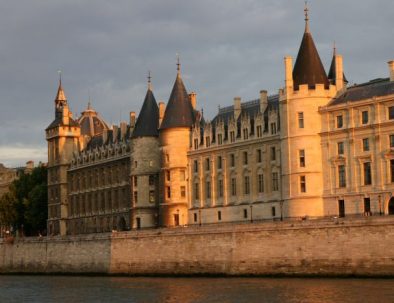
Meeting point
Rue de Lutèce, at the exit of the metro stop Cité (line 4)
An amazing fresh look on Paris
Discover Paris from every angle possible : our itineraries are designed to bring you authentic experiences of Paris' neighborhoods and major attractions.
A knowledgeable and entertaining tour guide
The Aime Paris tour guides are friendly, educated, enthousiastic, reliable, energetic, with academic background and professionnal experience. They are used to dealing with groups of all ages and sizes. They are able to offer tours in different languages.
A fascinating guided tour
Guided tours are the best way to get to know Paris, from the most famous monuments to the secret places only parisians know about. Learn everything about Art, Architecture and History in a fun way !
Easy access to the Parisian sights
The Aime Paris tour guides are holders of the Guide Conférencier National professional badge (the highest tourist guiding qualification in France), therefore they are able to use special entrances at certain well known attractions to avoid waiting in long lines.
Other guided tours you might be interested in :
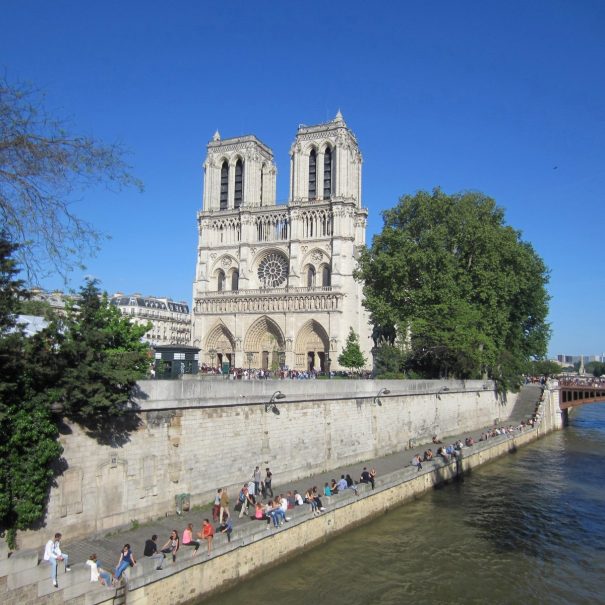
Notre-Dame & the City island
The City Island guided tour Considered as the craddle of the city, the Île de la Cité (city island) is in Paris’ very center. Explore its old streets, picturesque river banks and majestic monuments such as Notre-Dame cathedral, Sainte-Chapelle and … Read More

Visitor’s Guide To La Conciergerie, A Paris Hidden Gem
Here’s my guide for exploring the Conciergerie in Paris. This medieval fortress stands proudly by the Seine, its turrets creating an imposing presence that captures attention.
However, the Conciergerie is more than just an architectural marvel. Step inside and delve into its enigmatic history. This impressive palace, with its UNESCO-listed grand hall and intricate turrets, holds secrets from centuries past.
During the French Revolution, the Conciergerie played a significant role as a major detention center. It became notorious as the final prison of Marie Antoinette, adding to its historical intrigue.
Prepare to be transported back in time as you explore the halls that once held prisoners and walk in the footsteps of those who shaped France’s turbulent past.
But the Conciergerie is usually overlooked by tourists who beeline next door to more famous Sainte-Chapelle. Indeed, I was told the Conciergerie was “just a gloomy barren place” with a vicious history.
But here’s my advice. If you’re a history buff, don’t let anyone dissuade you from visiting this less touristy hidden gem in Paris . It’s well worth a visit.
>>> Click here to book a skip the line Conciergerie ticket

The Conciergerie hides a scandalous past full of murder and mayhem. Personally, I like a vibe of darkness, medieval gloom, and French Revolution gone awry when taking my geographical cures.
Geographical cures can’t all be sunshine, beaches, and unicorns. Not when there’s Gothic architecture to behold and the French Revolution to re-live. I would take an ancient building with pointy arches over a beach most days anyway.
Besides, it was winter in Paris when I cast my eyes on the Conciergerie. There was no sunshine to be had. It was a dark day in the City of Light. As the rain droned on, I felt like I was in Caillebotte’s famous painting, Paris Street, Rainy Day .
The Conciergerie’s gloom mirrored the typical gloom of the ungodly gloomy month of February. And, that day, the mighty fortress provided respite from the driving rain that had soaked Paris’ cobblestone streets. My point is that it was the perfect day to visit a venue redolent of crime and death.
A Short History Of La Conciergerie
The Conciergerie has had myriad incarnations. It’s morphed from a medieval palace to a torture prison to a notorious guillotine way station to a public museum.
The Conciergerie was built in the 6th century. It was the residence of Clovis, the first King of France. Today’s version of the Conciergerie dates to 1200, when the building was formally known as the the Palais de la Cité.
The French kings and queens abandoned the gloomy palace in the 14th century and decamped for brighter digs.
They took up residence in the Louvre , Chateau Vincennes, and Versailles . When King Charles V, the last royal resident there, moved out for good, he appointed the first “Concierge” and renamed the building La Conciergerie.
The Concierge was charged with keeping order, overseeing the police, and supervising prisons. The Conciergerie was used as a seat of parliament.
Part of the Conciergerie, The Bonbec Tower, was converted into a prison. The torture there was so insidious and resulting misery so loud that the prison tower was graphically nicknamed “The Babbler.”
Then along came the fast and furious French Revolution. Enlightenment ideas had spread and stoked a revolutionary fervor in the Latin Quarter . The monarchy’s proposed new taxes caused widespread resentment and were the last straw.
The people wanted equality. And bread. On July 14, 1789, rabid rioters stormed the Bastille, and the French Revolution began with a bang.
After toppling King Louis XIV, there was a tiny period of relative harmony. The Declaration of the Rights of Man and of the Citizen was enacted. Still, some architects of the revolution, like Robespierre, Desmoulins, and Danton, were not satisfied.
These extreme Jacobins wanted the Ancien Régime utterly eradicated. They prevailed, and the glorious French Revolution transmogrified into a dark bloody event.
In 1792, revolutionary forces captured and arrested King Louis XVI and Queen Marie Antoinette as they attempted to flee the country. Monarchy was abolished. The king and queen were charged with treason and thrown into the Conciergerie.
READ : Guide To Marie Antoinette Sites in Paris
Then came 1793 and 10 months of utter hell that would live in infamy. Led by Robespierre, the radicalized revolutionaries unleashed the infamous violence known as the Reign of Terror. Terror became “the order of the day.”
“Enemies of the people” were imprisoned without trial and duly “sentenced.” The verdict was either innocent or death, no murky middle ground. Under the Law of Suspects, citizens could be classified as an “enemy” based on the slightest hint of opposition.
Sometimes the revolutionary leaders accused people they didn’t like or wanted out of their way. Evidence was not a valued legal concept at the time.
The Conciergerie became the “antechamber of the guillotine,” the last stop before people were marched to the guillotine at the Place de la Concorde and decapitated.
In total, up to 40,000 people were killed before there was a reactionary blow back and more moderate forces prevailed. Even Robespierre got a taste of his own medicine and was hoisted on his own guillotine-petard.
Guide To La Conciergerie, What To See
1. the exterior facade.
The medieval facade of the Conciergerie is best seen from the Right Bank.
The building includes four stately Gothic towers: the Bonbec Tower, the Silver Tower, the Caesar tower, and the Horlage Tower.
The oldest tower, the Bonbec Tower, was infamous for torture, as described above. The Silver Tower was the royal treasury. The Caesar Tower was named in honor of the Roman Emperors and the historic Roman presence in Paris.
The Horlage Tower was built between 1530-33 and is over 150 feet tall.
The tower showcases a beautiful clock , which Charles V conceived as Paris’ first public clock. It was installed in 1535 and gilded in 1585.
The clock was severely damaged during the French Revolution. But it was restored by the clockmaker Pierre-Michel Lepaute in 1849. It still chimes every hour on the hour, and keeps time for French citizens.
Once inside the Conciergerie, you’ll experience one of Europe’s finest examples of secular Gothic architecture. It’s an easy one way circuit.
2. Hall of Soldiers
You begin in the great Hall of Soldiers, the Salon des gens d’armes, declared a UNESCO site in 2006.
The hall was built between 1302-13 by Enguerrand de Marigny. It’s a massive four aisled room with an impressive vaulted ceiling and four large fireplaces. It’s 210 feet long with 28 foot ceilings.
It’s the oldest surviving medieval hall in Europe. You’ll feel like you’re standing in a Gothic palace.
This was the barren place I was advised to “skip” …
I loved the medieval eeriness. It was deadly quiet, even a footfall broke the silence. The desolate setting seemed suited to a gloomy day and a gloomy (but fascinating) historical topic. You can feel history pouring from the walls.
During the Reign of Terror, prisoners were huddled en masse in the great hall. They were interrogated, tried, and then escorted to prison down the “Rue de Paris,” the walkway of the executioner, by “Monsieur de Paris,” the executioner himself.
There are small rooms on the sides, which have displays and convey what life was like in the prison. There is also a video on the history of the place.
3. Guards Room
You can visit the Guards Room, the Office of the Keeper, the kitchens, and the Toilette. The Guard’s Room was an antechamber where the King held meetings with his council and dispensed justice. It was built in the early 14th century during the reign of Philippe IV.
The hall is supported by stout pillars with interesting capitols. They supposedly depicting the famous love story of Abelard and Heloise , who are buried in Pere Lachaise Cemetery .
The Toilette was where the prisoners had their hair shaved before heading to their grisly death.

4. Memorial Room
Upstairs, there is a memorial room that honors the citizens murdered via the guillotine.
Robespierre is on the list. So is Charlote Corday who stabbed another radical Jacobin, Jean-Paul Marat, in his bathtub.
She said: “I killed one man to save 100,000.” Even Danton was later guillotined for questioning the scope and extreme violence of the Terror.
5. Prison Cells
You can see several prison cells, some with creepy life size mannequins of incarcerated men. The dank dungeons are a stark contrast to the beautiful architecture.
The prisoners’ quality of life depended on their personal wealth and whims of their jailers. Only celebrity prisoners got their own cells. Middle class inmates were put in “pistoles” with a simple bed and table.
The poor were stuffed into a single cell with straw floors. The cramped cells were infested with rats, and the stench of urine permeated every room — a gruesome existence indeed.
6. Marie Antoinette Exhibit
Downstairs, there’s an exhibit featuring Marie Antoinette , the Conciergerie’s most famous prisoner. It’s decidedly unsatisfying and not “her cell.”
Marie Antoinette was imprisoned in the Conciergerie for two months in 1793 during the Reign of Terror.
It’s a kitschy memorial, a reconstructed staging of her cell with her posed in a long black veil. It is not the real deal. The actual cell was demolished and is now an expiatory chapel, so it’s been altered as well.
I found this bait and switch confounding, and perhaps a touch theme park-ish. Victor Hugo called it “respectful vandalism,” since we are not, in fact, seeing what the queen saw and experienced.
Shouldn’t the actual cell have been left intact and exhibited with historical accuracy? I felt like the exhibit (and chapel) were a sad bit of counter-revolutionary propaganda, designed to rehabilitate the image of the despised queen.
Even if she never said “let them eat cake,” she was an undeniable example of overweening royal decadence.
The accompanying signage confirmed my suspicions. Marie Antoinette is described as “brilliant” and the signs don’t even explain the reason for her arrest and death. Quelle fraude!
Rather annoyed, I carried on to the next chapel.
7. Chapel of the Girdondins
The Chapel of the Girondins is dedicated to the 21 deputies of the Girondin party.
The Girondins were moderate revolutionaries who became victims of the overzealous Jacobins and were sentenced to death for the sin of not being liberal enough.
The chapel commemorates a feast the Girondis held the night before their execution on October 30, 1793. Legend holds that the Girondins sang the Marseillaise , the national anthem of France, on the way to the guillotine.
8. Corner of the Twelve
Passing through the chapels, one comes to “The Women’s Courtyard,” where prisoners washed their clothes and ate. One corner is known as the “Corner of the Twelve” or “Corner of last goodbyes.” This was where condemned prisoners waited by the dozen to be carted off to the guillotine.
Despite its practically intact medieval appearance, the Conciergerie was extensively renovated in the 19th century.
In 1914, the Conciergerie was classified as a national historic monument. It’s been open to the public ever since. Much of the Conciergerie is still used for the Paris Law Courts.
Whew, even though I willingly embraced the gloom, I felt like there was nothing left of me after my visit to the Conciergerie.
If you have had enough gloom and doom, you’re in luck. The Conciergerie is connected to one of the most truly beautiful colorful buildings in all of Paris: the incomparable Sainte Chapelle .
Built by Louis XIV in the 13th century, the royal chapel is a masterpiece of Gothic architecture and stained glass. You can go from gloom to glorious in an instant.
Click here to book a ticket to Sainte-Chapelle. To save a few euros, you can also buy a skip the line combined ticket .
Practical Guide & Tips For The Conciergerie:
Address: 2 boulevard du Palais 75001 Paris
Entry fee: 11.50 € with a histopad included. Click here to book a ticket.
Hours: Open daily, 9:30 am to 6:00 pm
Metro : line 1, station Châtelet; line 4, stations Saint-Michel or Cité; lines 7, 11 and 14, station Châtelet
I hope you’ve enjoyed my guide to the Conciergerie. You may enjoy these other Paris travel guides and resources:
- 5 Day Itinerary for Paris
- 3 Day Itinerary for Paris
- 2 Day Itinerary for Paris
- 3 Day Impressionism Tour of Paris
- Hidden Gems in Paris
- Best Museums in Paris
- Guide To Montmartre
- Louvre Survival Tips
- Guide To the Musee d’Orsay
- Secret Day Trips from Paris
- Tips for planning a trip to Paris
If you liked to visit the Conciergerie, pin it for later.

Leave a Comment Cancel reply
Save my name, email, and website in this browser for the next time I comment.
Last Updated on July 6, 2023 by Leslie Livingston
Partenaires et ressources externes
Things to do around the monument
Groupes extrascolaires
Centres de loisirs, associations, maisons de quartiers, programmez des activités ludiques pour découvrir la Conciergerie.
Practical information
Find here all the practical information to prepare your visit to the Conciergerie
Visits and activities
Groups in the social field.
Discover our offer for groups in the social field.
Discover all the practical information for your group visit!
Are you visiting the Conciergerie with your family? Discover all our offers!
Visitors with disabilities
Discover all the services and offers for visitors with disabilities.
Display 9 View more of 9

- Top Attractions
- Tourist Attractions
Conciergerie
The Conciergerie was built as a Royal Family residence and seat of the French Parliament between the tenth and fourteenth century, the building was turned into one of the worst prisons of the period in 1392 .
The edifice was converted into a prison when the King Charles V, who had been living in the Conciergerie, decided to relocate to the other side of the River Seine. Very few prisoners made it out alive of this penitentiary.
The word “conciergerie”, which in French means the lodging of a housekeeper, was the name given to the prison, as it was part of the building that was looked after by the person left in charge of the palace in the absence of the King.
Visiting the Conciergerie
Today, in the Conciergerie, there is a small reconstruction of the different revolutionary cells, where visitors can appreciate the living conditions of the poor convicts who slept on the floor in a completely bare prison cell to the wealthiest prisoners who were given a bed, furniture and sometimes even servants.
There is a very detailed reconstruction of Marie Antoinette’s cell , which after having tried to escape, was guarded at all times by watchers who remained in her cell up until she was executed.
During the years the Conciergerie was used as a penal institution over 2,700 prisoners were executed including famous French individuals such as Marie Antoinette.
An Interesting Visit if it's Free
It is worthwhile discovering the terrible living conditions of those incarcerated in the Conciergerie while they waited to be executed in the Place de la Concorde only if you can access the building for free. Otherwise, in our opinion, it is not worth paying the entrance fare.
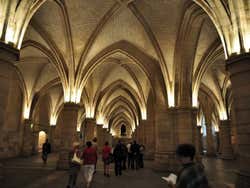
In the Île de la Cité, very close to Sainte Chapelle
Open daily: 9:30 – 6 pm
Adults: € 11.50 ( US$ 12.50) Under 18s and EU Citizens (18 - 25 years old): free entry Persons with reduced mobility and accompanying person: free entry Free entry with the Paris Pass and the Paris Museum Pass .
Conciergerie Ticket € 13 ( US$ 14.10)
Metro : Cité , line 4. Bus : lines 21, 24, 27, 38, 58, 81 and 85.
Nearby places
Île de la Cité (97 m) Sainte Chapelle (137 m) Latin Quarter in Paris (342 m) Notre Dame Cathedral (453 m) Musée Cluny (655 m)
You may also be interested in
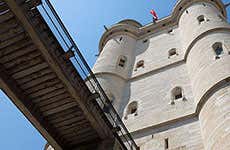
Château de Vincennes
Built at the end of the twelfth century, the Château de Vincennes (Vincennes Castle) is the only Royal residence built during the Middle Ages that is still intact.
As the capital of arts and one of the main tourist destinations in the world, Paris houses over 150 museums. These are some of the most important museums in Paris:
Enter a search term or a page code from the guide.

The Conciergerie in Paris – Palace and Revolutionary prison
A former royal palace and revolutionary prison.

Your one-stop travel plan with all the info you need
Add this and other places to your personal travel plan. We will then help you with further suitable suggestions: free of charge and fast!
Sandwiched between the soaring Notre-Dame cathedral and dazzling Sainte Chapelle , the Conciergerie is another historic jewel in the former royal heartland, Île de la Cité .
Related articles
- The best sights in Paris
- The travel guide to Ile de la Cité in Paris
- The Notre Dame in Paris
Situated atop a Roman fortress and expanded by generations of early French kings, the magnificent halls of the former royal palace would later house the country’s highest court . Under the Palais de Justice lies haunting prisons that held many victims of the French Revolution, including Marie Antoinette.
Ticket info for you
Today, the French appeal court still presides there, yet there is much for visitors to enjoy. Not least the spooky prison. A millennium of history reverberates from the walls of the Conciergerie, making it one of the most fascinating destinations in Paris .
table of content
What is the Conciergerie in Paris?
Today, the Conciergerie is the oldest surviving structure from the historically important Palais de la Cité. In one part sits the Cour de Cassation, France’s appeal court, and the country’s most senior judiciary. On the other is what remains of a royal palace and atmospheric prisons , revealing different perspectives on Parisian history.
If you’re not involved in legal wranglings, your journey into the Conciergerie begins in the cavernous Salle des Gens d’Armes . The Hall of the Soldiers is a soaring-arched hall completed in 1302. It’s an arresting introduction to a landmark dripping in history .

Frankish kings ruled from the small Île de la Cité since the 6th century. In the 10th century, Hugo Capet ordered construction of the Palais de la Cité. Sainte Chappelle, ornate towers, and spaces like the Grand Hall would be added by later kings. The distinctive Tour de l’Horloge was installed by the mad king Charles VI and displayed the first public clock in Paris . It remains an eye-catching sight that you can set your watch by.
By the 13th century, Philip II had established a parliament in the Conciergerie, making it the center of royal justice. After placing the state archives there, he appointed a custodian, or a concierge. Half a century later, Charles V would move to the Louvre, and the monarchy never returned. But the judicial role of the Conciergerie continued expanding, with subterranean prisons later added. When fires were lit under the French Revolution, the Conciergerie would earn a grim legacy when the Revolutionary Tribunal condemned 2,780 prisoners to the guillotine. Among them was the queen, Marie Antionette.
The courthouse in the Palais de la Cité, popularly known as the Palais de Justice, remains to this day. The Conciergerie and its prisons were still in use until 1934. Remarkably, that’s 20 years after tourists started poking around the former royal palace. You can now poke around the restored cells , which are thankfully empty.
Tickets and entrance to the Conciergerie
Because the Conciergerie sits behind the security perimeter of the Palais de Justice, tickets must be booked online.
- Ticket entry costs €11.50 – includes the augmented reality ‘Histopad’ for self-guided tours (under 18s go free.)
- Free entry is also available for EU and EEA nationals aged 18-25.
- Dual-entry tickets to Sainte-Chapelle and the Conciergerie cost €18.50 (a €3.50 saving.)
- Paris Museum Pass : The Conciergerie (and Sainte-Chapelle) is included in the 2/4/6-day Paris Museum Pass, along with 33 other museums and attractions. Passes cost €55.00 – €85.00 and offer real value if you plan to visit multiple landmarks.
Tours of the Conciergerie
Dive into the mysterious and exciting history of the Conciergerie of Paris with an expert on your side. One of the many local guides will tell you everything you need to know about the French Revolution and the different functions of the former prison.
"The History of Paris" Tour

Look out for the Rue de Paris corridor leading to the prisons, upsettingly named after Monsieur de Paris, title of the city’s executioner. The Palais de la Cité is fascinating, but the prisons and associated revolutionary legacy steal the limelight . Several rooms set the context, exploring the changes to the justice system during and after the French Revolution. It sets the mood for walking down the Prisoner’s Corridor, past the clerk’s desk, a room for cutting hair, and three cells.
Poignantly, the journey takes you to the Salle des noms , where the names of the 4,000 prisoners tried by the Revolutionary Tribunal are displayed. Among them is Queen Marie Antoinette. Equally, diverting are the chapels and women’s courtyard. The exploratory chapel of Marie Antoinette was converted into a memorial in 1815 when the Bourbon monarchy was restored. After coming back up fo
r air, stop at the Tour de l’Horloge completed in 1350. The clock tower once bore Paris’s first public clock .
Tips for visiting the Conciergerie
Make the most of your visit with a few tips for seeing the Conciergerie:
- Monday to Friday, bag searches and extra security for the courts next door slow visitors down. Add 15 minutes to your planned visiting time.
- Saint-Chapelle is the sister building to the Conciergerie. Chances are you’ll want to see the royal chapel and mesmerizing stained-glass windows, so buy the dual-entry ticket to save Euros.
- If you get hungry, the Brasserie Les Deux Palais opposite is decent. There is even more choice in Place Dauphine and in neighboring Île Saint-Louis .

Remember to reserve!
Remember to reserve online Monday to Friday, even if you qualify for free entry. Security precautions necessitate advance booking.
Is the Conciergerie worth visiting?
The Conciergerie ranks among the most absorbing historical sites in Paris . A palace to Frankish kings for centuries, later transformed into a courthouse and revolutionary prison, its towers have witnessed momentous events. Today, you can get a flavor of a Paris gone but not forgotten. It’s another unforgettable destination on the captivating Île de la Cité .
History facts about the Conciergerie in Paris
The long and twisting history of the Conciergerie hides many secrets from Parisian history.
A Gallo-Roman fortress from the 1st century AD once stood where the royal place was raised. France’s first king, Clovis, set up home there. But the Frankish kings moved on, only to return in the 10th century, when Hugh Capet established the capital of the Kingdom of France there. The Palais de la Cité followed, parts of which remain today. Subsequent kings enlarged and embellished the palace.
The flood-prone island was definitively abandoned by Charles V in the 15th century. Instead, a concierge was appointed to administer the former palace as a parliament and to administer the king’s justice. The Conciergerie’s name stuck for the parliamentary halls and prison. The adjacent courthouse became better known as the Palais de Justice .
The Conciergerie was later central to the French Revolution. First, after refusing to hand over members for interrogation under the King’s orders. Later, as a target of the swirling revolution. During the notorious September Massacre in 1792, the Revolution reached a fever pitch. Hundreds of prisoners were killed. Many were slain in the Women’s Courtyard of the Conciergerie , which you can visit today. Less than a year later, the Revolutionary Tribunal set up their infamous courthouse. 4,000 prisoners were tried. 2,780 were condemned to the guillotine.
Marie Antoinette was tried and imprisoned there before the execution. As was Robespierre, the blood-soaked tyrant who engineered the Terror that eventually consumed him. In 1814, following the Bourbon Restoration , the Palais de la Cité resumed its role as courthouse and prison. The prison remained in use until 1934, 20 years after the royal palace was opened to tourists. During that time, several notable were imprisoned there, including Marshal Ney, Napoleon Bonaparte’s ‘ Bravest of the Brave ’.
One other highlight of the Conciergerie are the towers added by different generations. Notably the clock tower unveiled in 1350.
What to do after visiting the Conciergerie
Visitors will find much to do in the vicinity of the Conciergerie. Sainte-Chapelle, the former royal chapels with extraordinary stained-glass windows, is part of the same royal complex.
- Moments away is the iconic Notre-Dame cathedral , soon to be fully restored after the devastating fire of 2019.
- If you’ve built an appetite, head to the tranquil Place Dauphine or across Pont Saint-Louis to the neighboring island.
- Take time to savor the views over Paris’s oldest bridge, Pont Neuf , from the Square du Vert Galant gardens.
- Across the bridges from Île de la Cité awaits some of the city’s most exciting neighborhoods , including Le Marais, the Latin Quarter , and Saint-Germain-des-Prés .
What is the Conciergerie today?
The Conciergerie forms one part of the historic Palais de la Cité, a former royal palace. In part of the complex sits France’s highest court. The Conciergerie has been preserved as a tourist attraction, letting visitors see the royal palace and the notorious prisons underneath.
Is there anything else to do near the Conciergerie?
Nowhere in Paris boasts such a concentration of celebrated landmarks and places to visit. The Conciergerie is minutes from Notre-Dame, Sainte Chapelle, Le Marais, and the Latin Quarter.
Is the Conciergerie included in the Paris Museum Pass?
Yes – The Conciergerie (and Sainte-Chapelle) is included in the Paris Museum Pass , along with 33 other museums and attractions.

The 30 best sights in Paris

The Travel Guide to Île de la Cité in Paris

Notre Dame in Paris: Probably the most famous church in the world

I love traveling! Whether it's the Australian outback, the fjords of Norway or city trips to the most beautiful cities in the world like Paris, Singapore, Barcelona or New York - I'll write down my best tips so that your trip will be a very special highlight.
Get exclusive content, real insider info and the best travel deals completely FREE!
Your trip start: We’ll provide you with little reminders to prepare for your trip and up-to-the-minute events when you’re traveling!
You have disabled JavaScript
JavaScript is required to use this website. Therefore, please enable JavaScript in your browser to visit this website.
Conciergerie in Paris: From ancient Royal Palace into iconic Prison

- Post category: Paris & Île-de-France
- Post author: Nassie Angadi
Paris is a city that lives and breathes history. From the Louvre to Notre Dame to the Sorbonne, it is a city that has managed to preserve its past. That historical allure is no better represented than the medieval royal castle on Ile de la Cité , one of the oldest in Paris.
Officially known as the Palais de la Cité (‘Palace of the city’ in English), this historic castle fortress today attracts millions of visitors from around the world.
It earned the nickname of the Conciergerie because it is here that a new royal position was created in the 12th century within the palace. The Concierge was responsible for the administration of the lower and mid-level law courts within the Palace. The palace later took its name from this position.
And with that the concept of the concierge who is responsible for the proper functioning of the premises (usually a hotel or restaurant) was exported around the world.
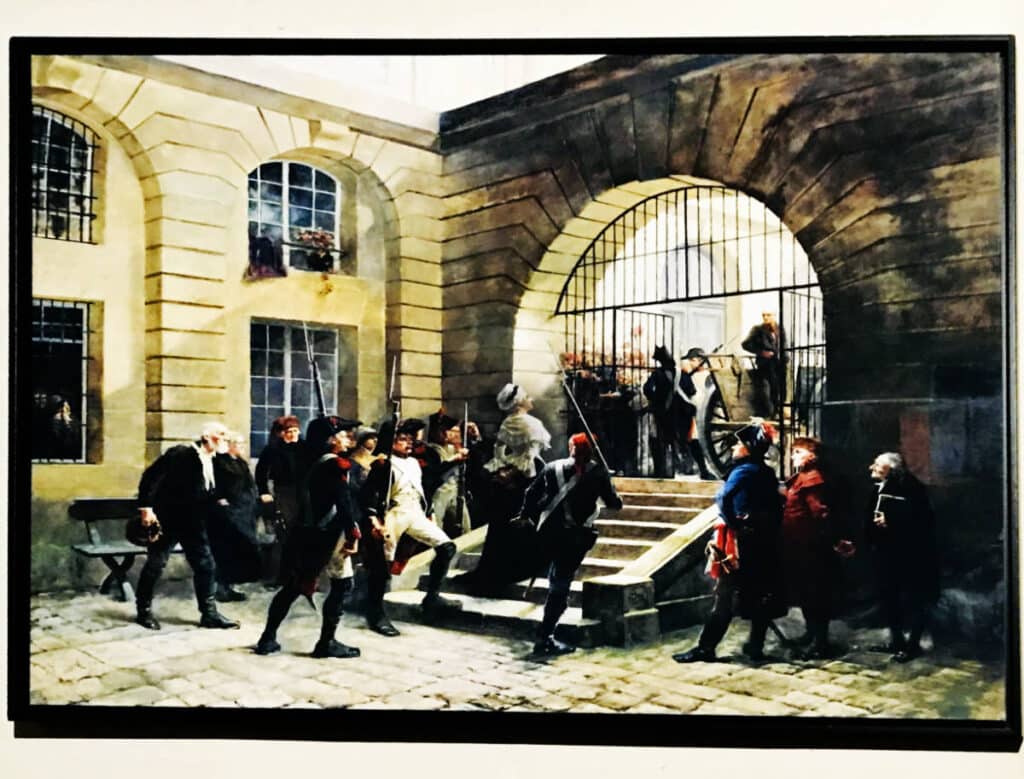
These days, visitors flock to the Conciergerie as it has become most famous for being Queen Marie-Antoinette’s prison. It is here that she was kept for 44 days until she was taken to her execution at the Place de la Concorde in Paris.
So let’s find out more about the history of the Conciergerie and other interesting facts about this amazing monument. Allons-y!
1. The first construction here was as a Gallo-Roman settlement in the 2 BC.
During the Iron age between 250 and 225 BC, a sub-tribe of the Celtic Gauls, called the Parisii settled on the banks of the Seine . They began to build a type of walled fort called an oppidum in the 2nd century BC. Some historians believe that this was around Ile de la Cité, where the Conciergerie now stands.
In 58 BC, the Romans conquered the region calling it Lutetia and building castle walls on Ile de la Cité, some of the foundations of which are still around today. (The comic books Asterix and Obelix centers around the intrepid Gauls fighting the dastardly Romans.)
A large Roman temple was located a few 100 yards away, where the Cathedral of Notre Dame de Paris stands today.
2. The ancient fortress became a royal palace.
Following the Romans came the Franks , including Clovis I who made Paris his capital and lived in that ancient castle till his death in 511AD. Later, his successor Charlemagne would expand the empire east with Aachen (Aix-la-Chapelle) as his capital, and ignore Paris.
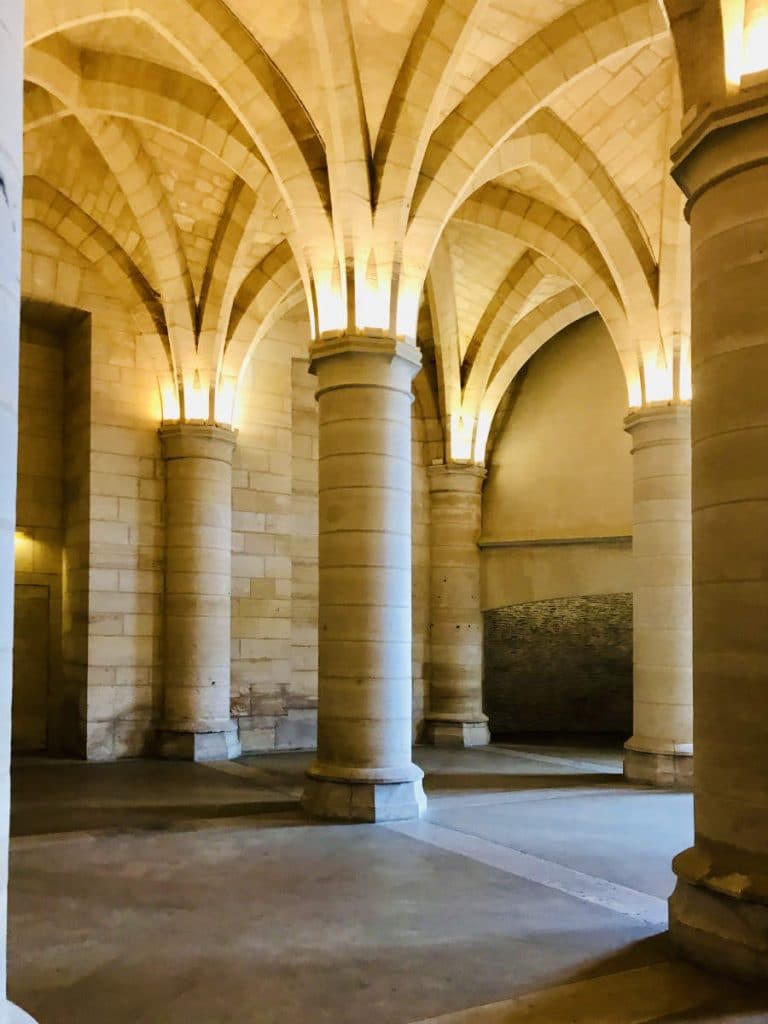
It would be the Capetian Kings ( Hugh Capet and his descendants) who would return to Ile de la Cité as their base in the 10th century, and turn the old fortress into a royal palace .
As the French monarchs ‘ power base, the walls were reinforced, gates constructed, and large halls added, and the palace became the seat of administration.
3. The Palais de la Cité royal residence was also a government building.
By the Middle Ages, the Palace on Ile de la Cité was a large royal residence and government including:
- Salle de Roi – the meeting room nobles and for the royal council
- Chambre de Roi – residence of the King
- Chapel dedicated to Saint Nicholas
- Chambre des Enquetes – which supervised public administration
- Grand’Chambre – a high court where Parliament used to sit under the Old Regime.
- Chambre des Comptes – chamber of the accounting and treasury of the kingdom,
- Chambre civile – civil case hearings
- Chambre criminelle – criminal case hearings
- several new offices to support the management of the finances, administration and judicial system
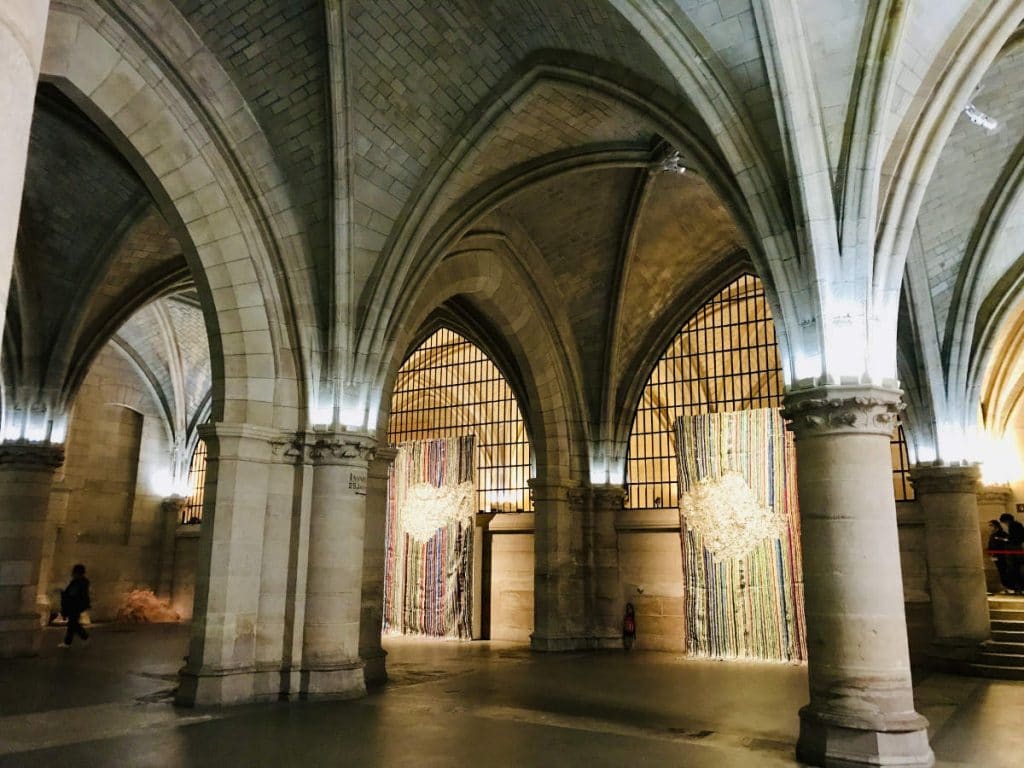
- Salle des Gens d’Armes
Today you can still see the following rooms that date back to the Middle Ages, in the Palais de la Cité:
- Salle des Gens d’Armes – Large hallway for armed guardsmen
- Salle des Gardes – guardroom that was the antechamber to the Grand’Chambre
- Large kitchens built by King Jean le Bon, where food supplies could be directly delivered by boats on the Seine river.
All this new bureaucracy housed within the Palace led to a rapid expansion to contain all these offices.
It also eventually led to conflict between the royal government and the nobles, who had their own high court in the Parlement de Paris which was also housed within the walls of the Conciergerie.
4. The Grosse Tour was built in the 12th century.
In the center of the Palace used to a donjon or tower, known as the Grosse Tour . Built in the 12th century, it was 11.7 meters wide at the base, with walls three meters thick. When a new Grosse Tour was built across the Seine at the Palais de la Louvre , it was called the “New Tower”.
This Grosse tower at the Conciergerie existed until 1776 when it was demolished. Today the Conciergerie has four remaining towers along the Seine, all of which date back to the Middle Ages.
The façade of the towers is more modern however, having been rehabilitated in the early 19th century.
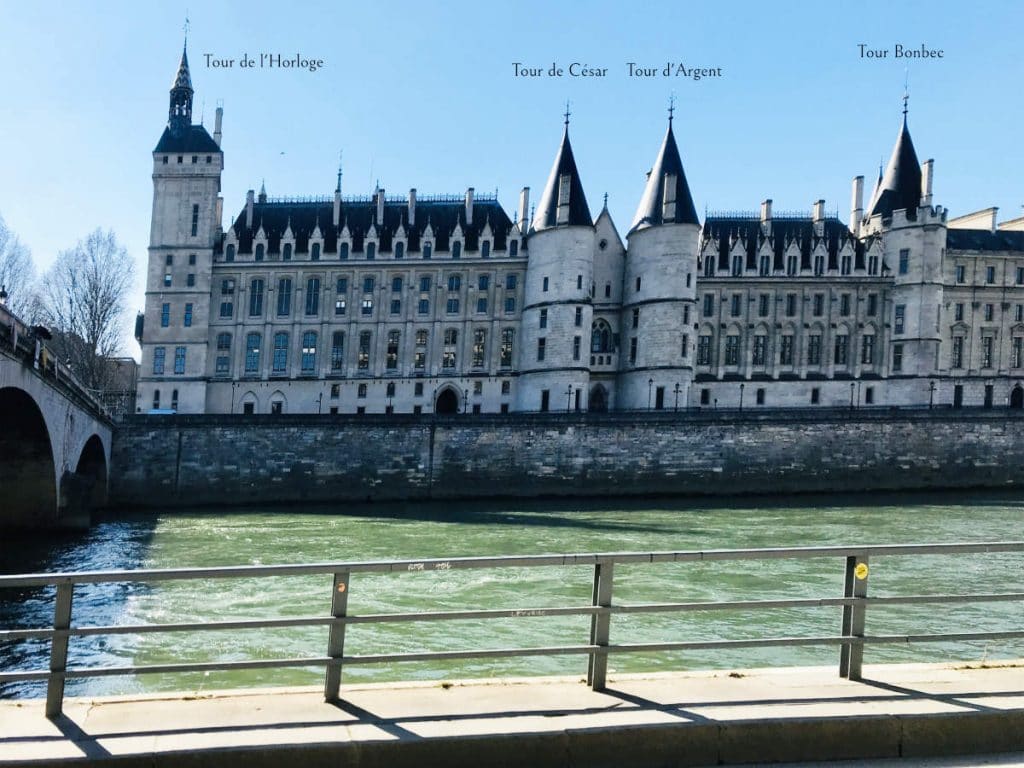
5. Tour Bonbec is the oldest tower still standing.
The oldest tower currently standing is the Tour Bonbec on the far right. It was built between 1226 and 1270 during the reign of Saint King Louis IX .
The tower does not have a pleasant history, having been the Conciergerie’s primary torture chamber during the Middle Ages. It was said that prisoners tortured would sing like birds, with a “ bon bec “, or beak open wide.
It originally was a story shorter than the other towers, but was raised to match their height during a renovation in the 19th century.
6. Tour de César and the Tour d’Argent are the two towers in the center.
The two towers in the centre of the Conciergerie that you see are the Tour de César and the Tour d’Argent which were built in the 14th century.
Each has four levels. The top levels held the offices of the clerks of the court, both criminal and civil. The lower floors contained jail cells.
7. Tour de l’Horloge contains the first public clock in Paris.
The tallest tower is the Tour de l’Horloge which was constructed by King Jean le Bon in 1350. The tower is at the intersection of Boulevard du Palais and Quai de l’Horloge and contains the first public clock in Paris, made by Henri d’Vic, which was added in 1370.
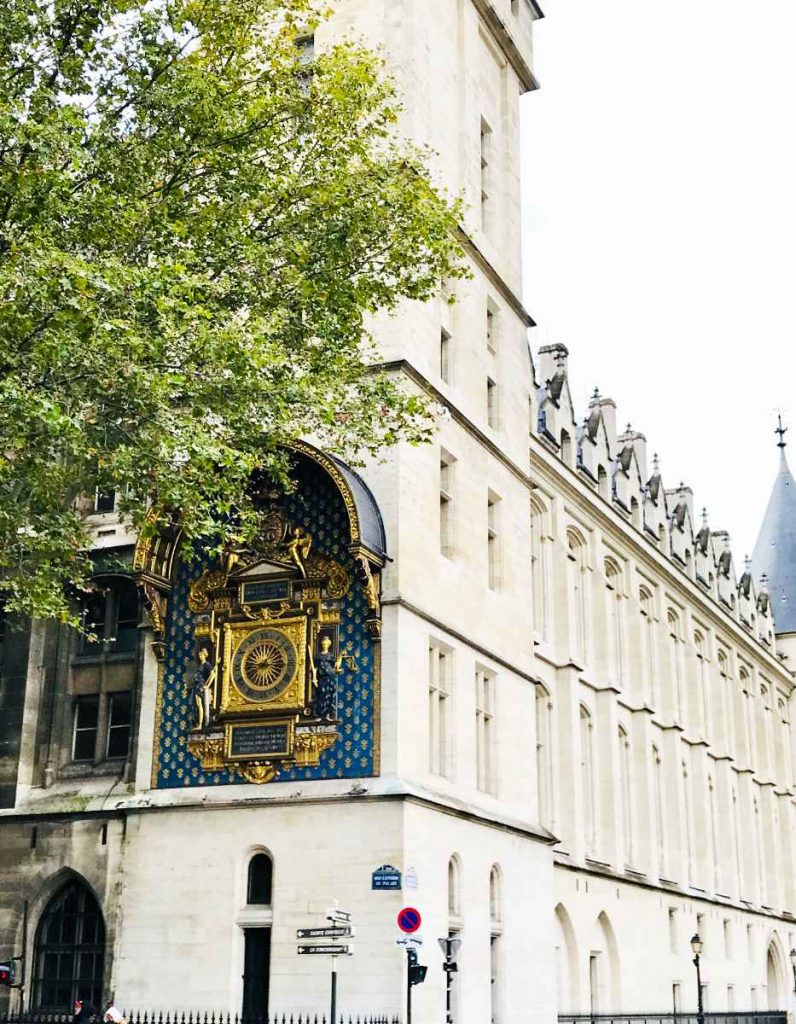
The sculptural decoration around the clock features the figures of Law and Justice which were added in 1585 by King Henry III. They were destroyed during the French Revolution but later restored.
Originally, at the top of the tower was a bell, which was rung to announce important events in the life of the royal family, like Big Ben in London, England. However, the bell was removed and melted down during the Revolution.
8. Inside the Conciergerie is the Sainte Chapelle.
At one end of the Palais de la Cité, you will find the Sainte Chapelle which was constructed in the 13th century by King Louis IX, later known as Saint Louis .
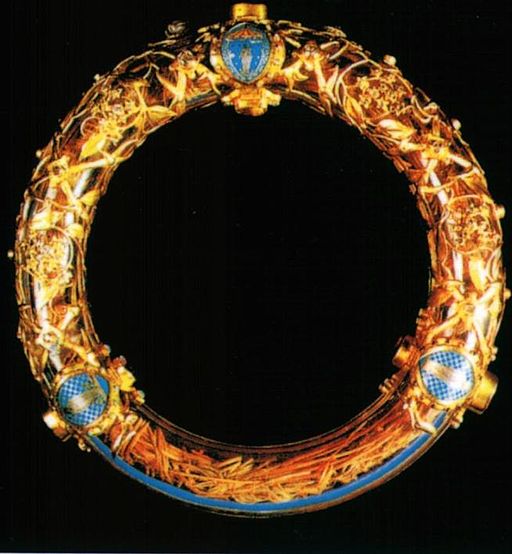
Saint Louis had earned a sainthood for bringing back the Crown of Thorns and other holy relics from the Crucifixion of Christ to France from Constantinople (today known as Turkey).
Saint Chapelle was built in order to hold the holy relics. The lower level of the chapel served as the parish church for Parisians , while the upper level was used only by the King and royal family.

Today when you walk into the chapel, you will notice the magnificent stained glass windows of the upper chapel. About half of them are original, while others have been restored over the ages.
It is considered one of the most important monuments of Medieval art in Paris. You can read more about Sainte Chapelle here.
9. Law Courts are still housed inside.
While the Palais de la Cité had housed law courts throughout much of the Middle ages, it was after the Revolution of 1789 that it took on a new importance, becoming its main function.
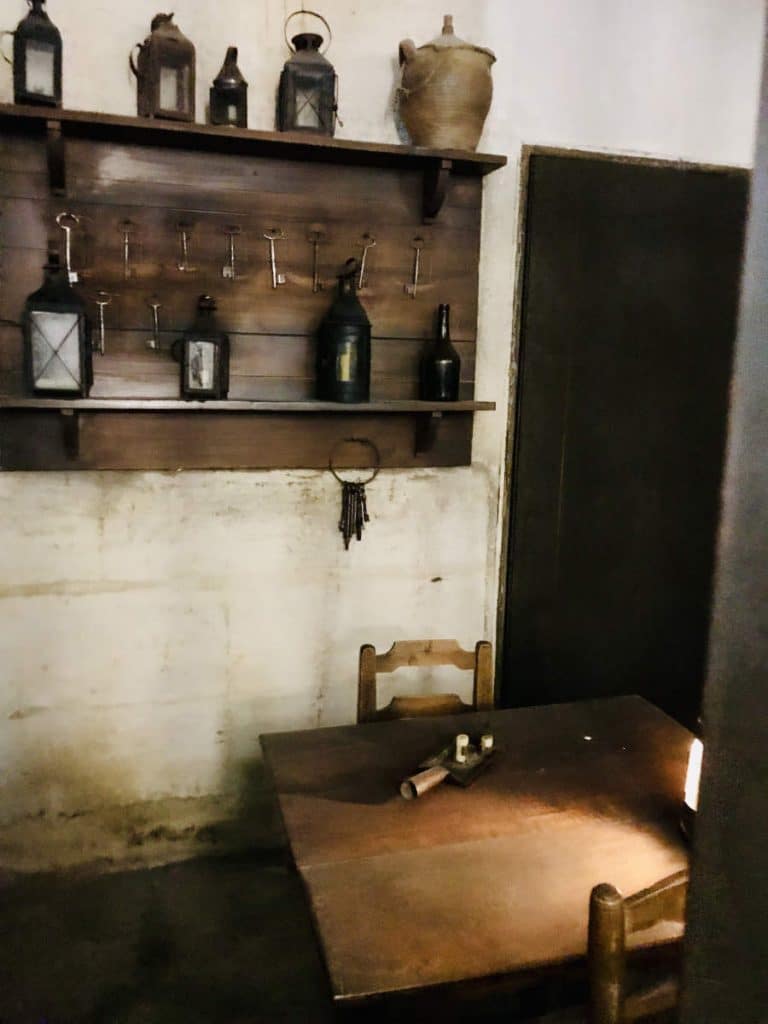
On July 14, 1789 , the fortress prison at Bastille Saint-Antoine was stormed by the revolutionaries and the country would never be the same again.
Needing a new prison, the Parliament offices in the Conciergerie were moved to the Salle du Manège (“Riding Hall”) in the Tuileries Palace , before eventually moving to the Assemblée Nationale .
The Conciergerie and Palais de la Cité was placed under the authority of the Mayor of Paris, as a tribunal and prison.
10. Marie-Antoinette had her judgement here at the Revolutionary Tribunal.
The most famous prisoner at Palais de la Cité was of course Queen Marie-Antoinette . After the execution of the former King Louis XVI, the revolutionaries debated what to do with the former Queen.
To get rid of her, they decided to try her at Revolutionary Tribunal on accusations of high treason (to her native Austria), promiscuity and incestuous relations with her young son Louis-Charles.
The Revolutionary Tribunal was set up in the Palais de la Cité in 1793, and Marie-Antoinette brought before it.
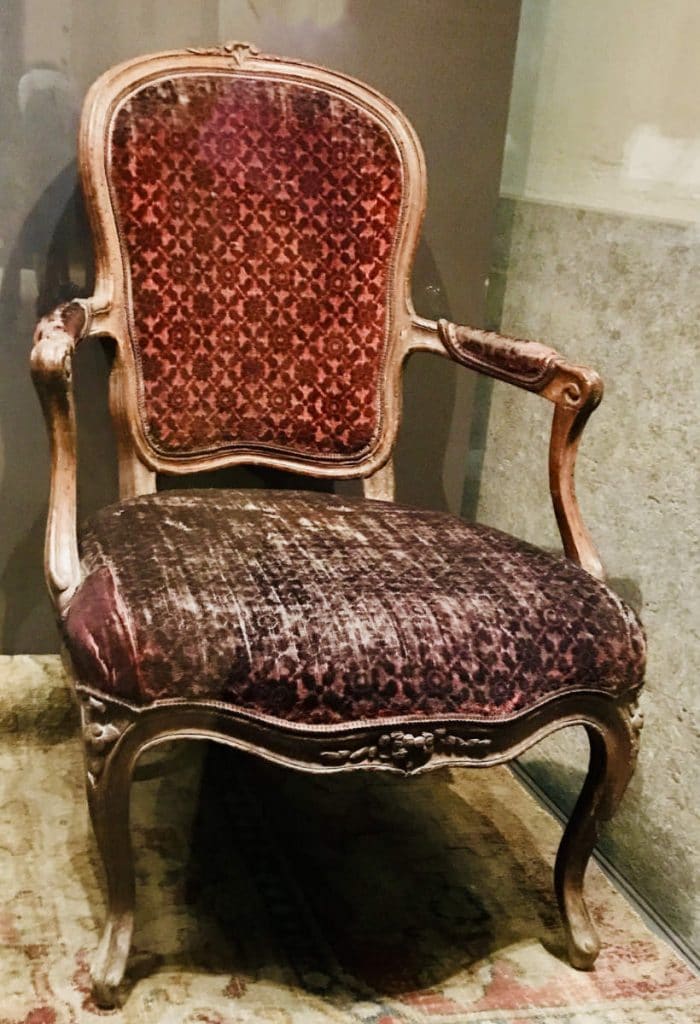
Her 7-year-old son was separated from his mother and forced to testify that Marie-Antoinette had molested him, which she declared was a great affront to her as a woman and a mother.
After a two-day show trial, she was found guilty on all charges and condemned to death.
11. Marie-Antoinette was kept in a prison cell here for 44 days.
Marie-Antoinette had previously been imprisoned in the Tower of Temple with her daughter nearby.
After the revolutionary tribunal, however, she was moved to the Conciergerie, the tiny prison cells being a far cry from the palaces the Queen was used to.
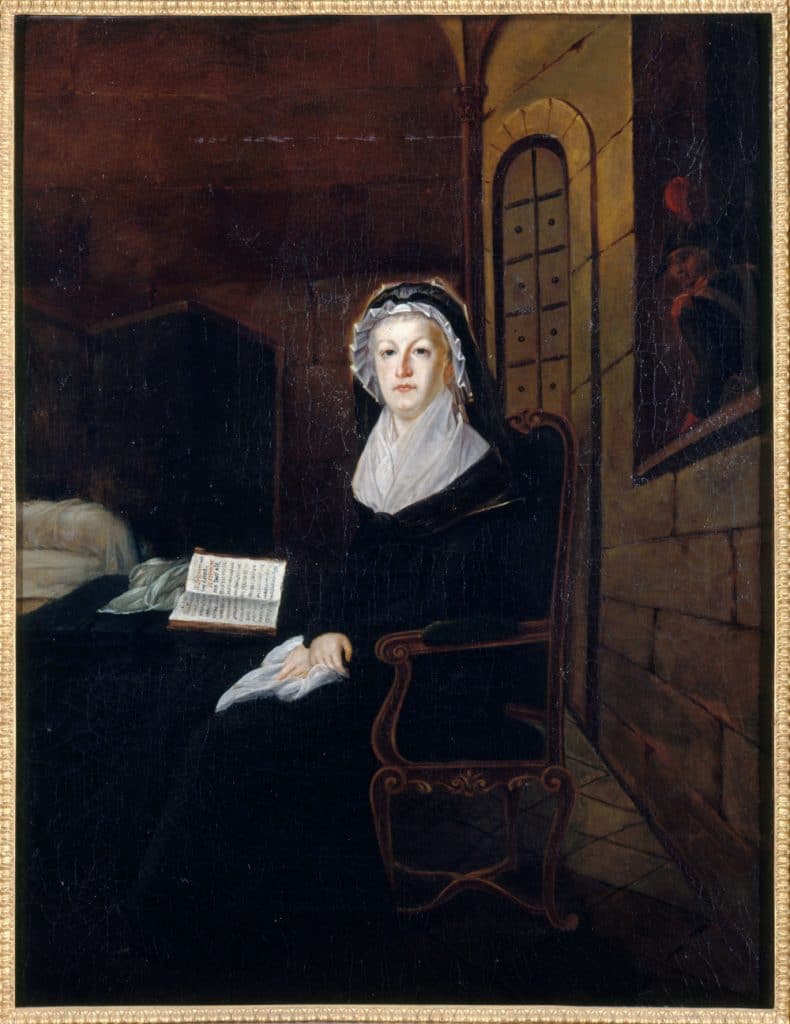
Around 10 months after her husband, on 16 October 1793, Marie Antoinette was beheaded what is now Place de la Concorde in Paris, with the crowds jeering.
Her last words are recorded as, “ Pardonnez-moi, monsieur. Je ne l’ai pas fait exprès ” or “Pardon me, sir, I did not do it on purpose”, after accidentally stepping on her executioner’s shoe.
After the queen’s head fell, it was shown to the crowd, who responded by crying: “ Vive la République! ”
12. Revolutionary Maximilien de Robespierre was imprisoned here.
If Marie-Antoinette was its most famous prisoner, the 2nd most famous would be her nemesis, Maximilien de Robespierre.
Robespierre was a lawyer who became one of most influential figures of the French Revolution. He was one of the leaders in charges against the King and Queen, passionately believing in a cause of the République.
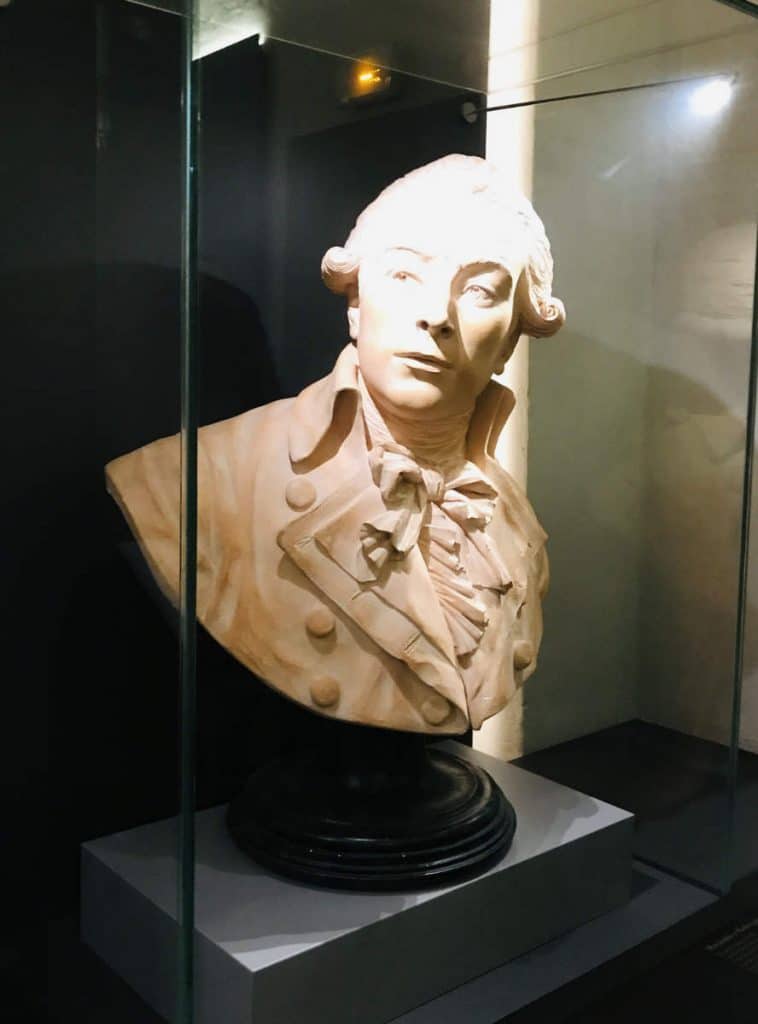
As part of the National Convention (which was more or less the Head of state at the time), he campaigned for universal manhood suffrage and the abolition of slavery.
However, he was so zealous in his actions to achieve his goals, (i.e. by sending people to their deaths), that he himself was arrested and imprisoned in the Conciergerie. He was guillotined just hours after his arrival, about 8 months after Marie-Antoinette in July 1794.
13. Many prisoners of the Reign of terror were kept here.
Once the revolution was in full force, a period of great instability occurred. It was known as la Terreur , or the Reign of Terror.
With warring sides and the balance of power constantly shifting, France was in a civil war with several revolutionary factions all claiming power.
Massacres were common, such as the September massacre in 1792, when around 1500 prisoners were died over 4 days, many at the hands by lynch mobs.
There are no exact figures, but estimates show that around 25,000 people were guillotined or massacred during the Reign of Terror, including several members of the Royal court.
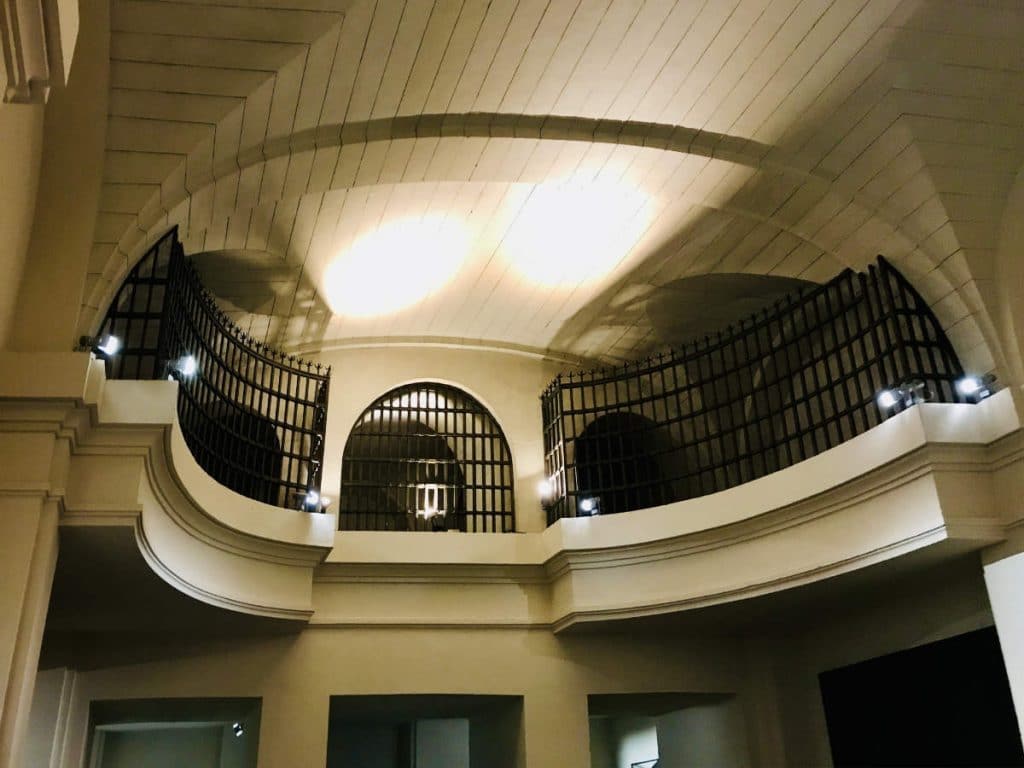
So many judgements and executions were taking place at the Conciergerie that the corridor to the prison cells earned the nickname the “ Rue de Paris “. This was derived from the “Monsieur de Paris”, which was the nickname given to the executioner of the Revolutionary Tribunal who came to see the prisoners.
When the Revolutionary Tribunal was finally abolished on May 7, 1795, it had a record of having put to death 2,780 people in a mere 718 days .
14. The Conciergerie is the headquarters of the French Judicial system.
Following the Revolution, the Palace became the headquarters of the judicial system of France, but also continued as a prison under Napoleon Bonaparte .
After the defeat of Napoleon at the Battle of Waterloo, the Bourbon dynasty was restored, with Louis XVIII (the brother of Louis XVI) as King. The Palais de la Cité would however continue in its role as the headquarters of the law court system of France.
15. There is a Memorial Chapel to Marie Antoinette and other royal prisoners inside.
Louis XVIII had a small chapel erected on the very spot of the queen’s cell to honor his deceased sister-in-law. You can see her initials on the alter and in a nearby glass-stained window.
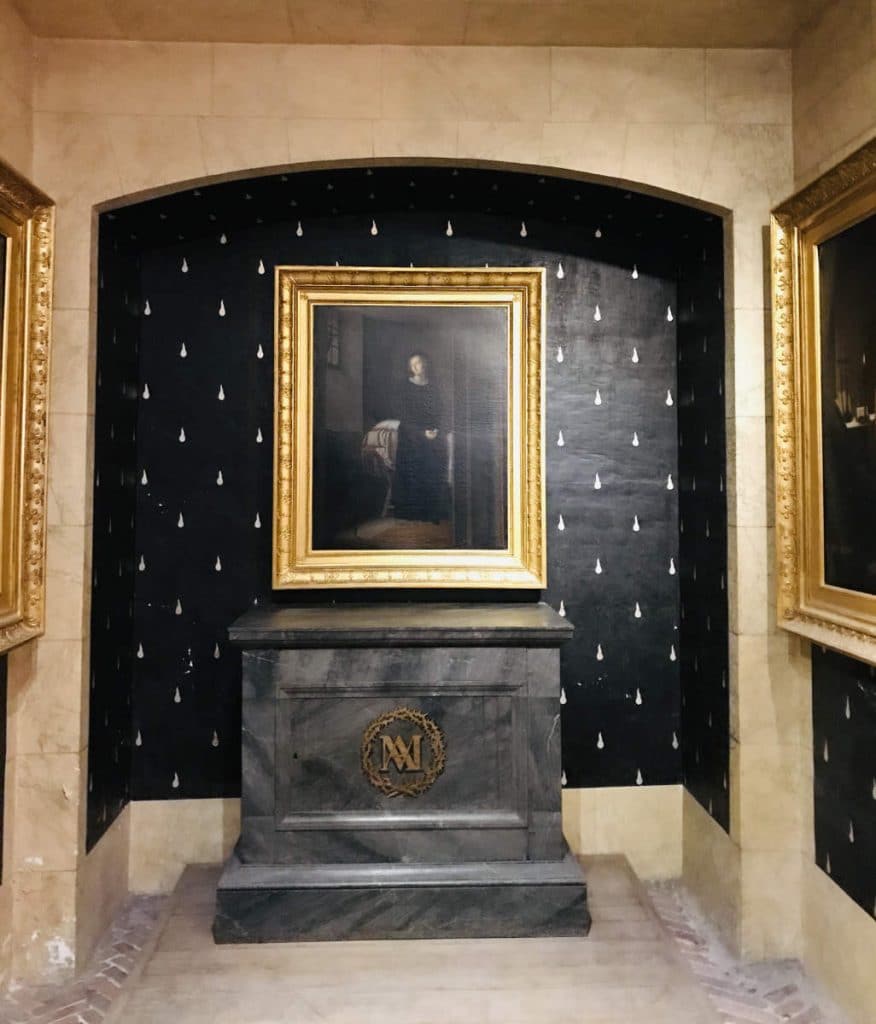
The chapel occupies both the space of her original cell and the nearby infirmary of the prison, where Robespierre was held before his trial and execution.
16. The Palais de Justice is a working courthouse.
Today, parts of the museum at the Conciergerie and Saint-Chapelle are classified as national historical monuments and can be visited.
The portion that contains the Palais de Justice however is still a working courthouse and is therefore closed to the public. It no longer holds prisoners, however.
17. The Prison courtyard has been transformed into a small garden.
A respite from all the doom and gloom is the prison courtyard, which today is has beautiful trees and benches to sit on. Bordered by two floors of dungeons, the courtyard was used by female prisoners to take daytime walks.
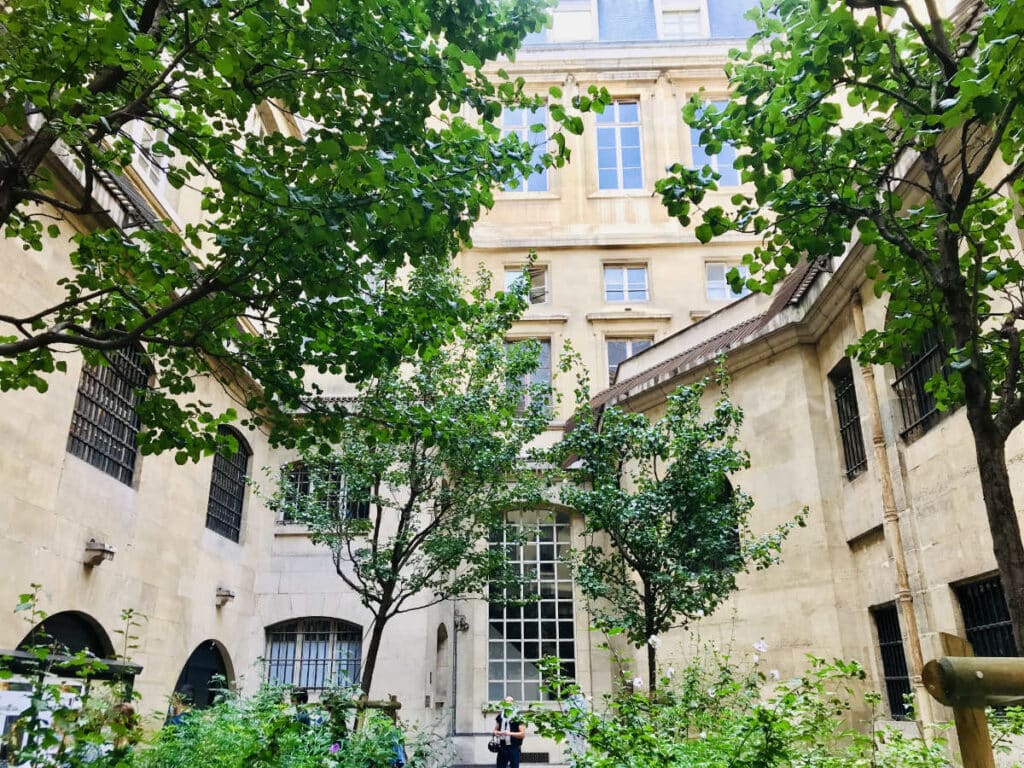
Is the Conciergerie worth a visit?
The inside of the Conciergerie is mostly empty, with a few prison cells having furniture inside to demonstrate conditions. There is a lot to read and experience, however this is unlikely to please small children. If you enjoy history, you will enjoy a visit to the Conciergerie.
When is the best time to go?
The area around Marie-Antoinette’s cell is quite narrow, so it can get quite crowded quickly. I would recommend going in the morning to visit, so that you can take it all at your leisure.
Where to get tickets?
You can get combined Conciergerie and Sainte-Chapelle skip-the-line tickets here.
If you enjoyed that article, you may enjoy reading more about the history of Paris . A bientôt!
You Might Also Like
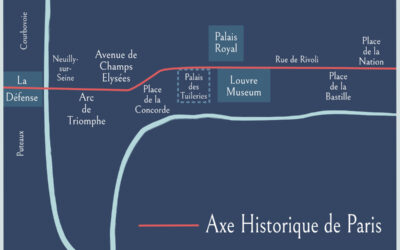
Axe historique of Paris: 9 Monuments that define the City of Lights

12 Tourist Traps: What NOT to do in Paris
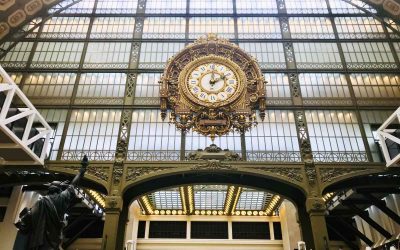
Musée d’Orsay (Paris): 14 Top highlights at the iconic museum

Château de Chantilly: The restored Royal residence near Paris
- Paris & Île-de-France
- Alsace & Lorraine
- Bourgogne-Franche-Comté
- Bretagne & Normandy
- Auvergne Rhône Alpes
- Loire Valley
- Northern France
- Nouvelle Aquitaine
- Provence & French Riviera
- Festivities
- Facts and history
- Get the Look
- Moving to France
- Appetizers & Starters
- Main dishes
- Side dishes
- Common Questions?
- Newsletters

Marie-Antoinette at the Conciergerie + St Chapelle on option
Private tour with skip the line / option: hotel pick-up/drop-off.
In the heart of Paris, visit The Conciergerie : the remain of a medieval Royal palace which became one of the main prison during the French Revolution, with the installation of the Revolutionary Court. This mythical palace abandoned by The Kings of France at the end of the XIVth century is still haunted by the ghost of a Queen once accused of all the monarchy’s sins. On option, visit the Sainte Chapelle with its unique Gothic style.

Opening Days 7/7 (every day)
Meeting-Point The conciergerie or your hotel / apartment
Duration 2Hrs or 3Hrs(St Chapelle)
Access Skip the Line
Transport Executive car on option
Type of tour Private, up to 17 people
Marie Antoinette at the Conciergerie BOOK NOW
With our effortless booking system From 115€/pers for 6

Because your family worth it, choose the best. Choose a 5 stars tour.
As a traveler’s best friend, your expert guide will enjoy sharing anecdotes and stories with you during this private tour.
Conciergerie Tour: what is included
- Enjoy a private tour with a friendly devoted expert.
- Feel like a Queen: skip-the-line tickets.
- Admission to the conciergerie.
- Headsets (if necessary) so you can always hear your guide.
- Possibility of an escorted Round trip drive from your place of stay to versailles palace (on option).
Place to see during this tour of the Conciergerie
- The Guards Room.
- The Hall of the soldiers built under King Philip the Fair.
- The kitchens built under King John the Good.
- The commemorative chapel erected on the site of the Marie Antoinette’s cell.
- On option, the Saint Chapelle dazzled by the 1,113 stained glass windows.
Before Versailles, before Vincennes and even before the medieval fortress that stood in place of the Cour Carrée of the Palace of the Louvre, there was one royal residence in the very heart of Paris : The Palais de la Cité , which remarquable remain, the Conciergerie has crossed the centuries. The Conciergerie can be considered as the most ancient trace of kings in Paris, an heritage from Louis IX (Saint Louis) and Philip IV (the Iron King), but it’s also the testimony of the tragic fate of the last queen of France.
This ancient medieval palace building was turned into prison at the end of the XIV century. But it’s during the French Revolution, that this place became the most terrible prison of France. A filthy prison indeed, where thousand of political prisoners were packed, summarily trialed and condemned to death before being transported to the guillotine. It’s no wonder then, why the Conciergerie was known as the antechamber of death.
In this prison, queen Marie Antoinette was thrown and spent the last nine weeks of her life as prisoner 208 of the Revolutionary tribunal. After 76 days, on October 14th 1793, Marie-Antoinette was put on trial for treason and other charges. The next day she was sentenced to death. On October 16th, she left the Conciergerie to meet her final fate at the place de la Concorde.
Today, in a splendid Gothic palace, the Conciergerie Museum recalls the glory of the greatest kings of the Middle Ages together with this most tragic episode of the end of the french monarchy.
Customization & option
- The Saint Chapelle : A gem of Gothic style. From the courtyard of the Conciergerie, you will reach that absolute masterpiece of Gothic architecture, built for Saint Louis to house precious Christian relics, including Christ’s crown of thorns the king had bought in Venice in 1239. Having these sacred relics in his possession made the already powerful monarch head of western Christianity. In the upper church of the chapel, walls have almost disappeared, the architecture is lightened as much as possible in order to leave room to the huge 15 period stained glass windows recounting scenes from the Bible. An impressive feat indeed which, from the inside, gives this place the stunning appearance of a splendid reliquary, a huge and most precious jewel-case bathed in golden and iridescent light.
- Walk up to the Revolution square (place de la Concorde) where Queen Marie Antoinette lived her last breath.
- Walk up to the Square Louis XVI , located in the heart of Paris. This lovely square, just a step from our office, where the French have lunch during Spring & Summer, also houses to the expiatory chapel, built in 1815 on Louis XVIII’s orders on the site of on old mass grave of victims of the French Revolution. In 1793, Louis XVI , Marie-Antoinette , and other figures, were buried there. This neoclassical building is dedicated to the memory of the royal family. Together with the Basilique de Saint-Denis , the Expiatory chapel is one of the memorial sites paying tribute to the French monarchy.
- Experience a 100% real VIP experience: discover the Conciergerie outside opening hours.
- Your guide can escort you (round trip) from your hotel to the Palace by public transport.
- Relax in our executive car with Chauffeur.
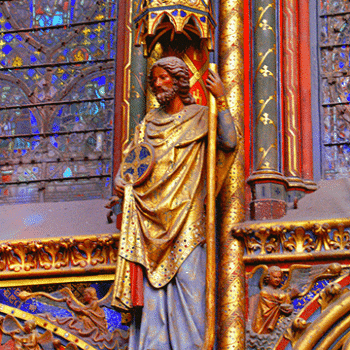
Detail Sculpture in the north of the Sainte Chapelle
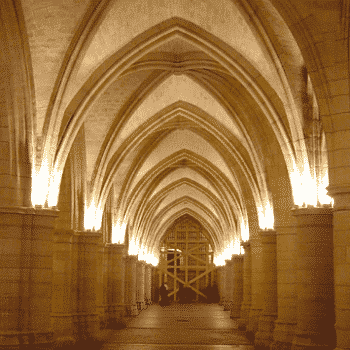
The Hall of the Guards: one of the largest surviving medieval parts of the Conciergerie.
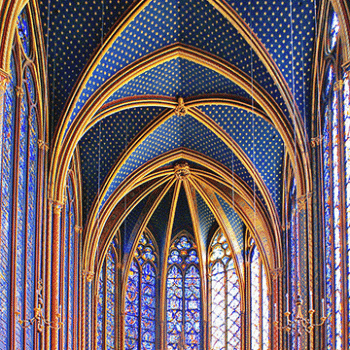
Upper level of the Sainte Chapelle
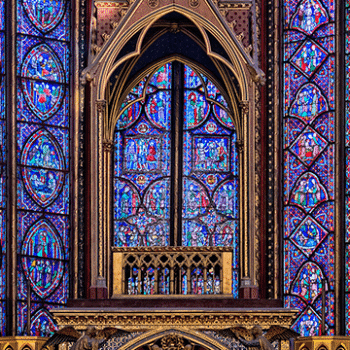
Apse of Sainte Chapelle

The Conciergerie closeup.
Price list ( click on the tour you wish to get the price )
** Basically we do not take the responsibility to carry your luggage during the day. If you need to tidy your luggage we can arrange it with an extra but we need to know it before booking. ** Visitors with disabilities can not access everywhere in the Conciergerie. Please contact us before booking and we will customize your tour.
Helpful Hints
We suggest you wear some sneakers and comfortable clothes. On Winter, we advise you to wear some warm clothes for a best experience. The best day to visit the conciergerie is during the week.
Safety ‘s Note
Next to the reinforcement of the security to enter in the Palace, the control may take longer than usual. Our skip the line tickets enable us to avoid the long queue. However you may have to wait a bit for the checking , especially during the high season.

Meet your guides

Elisa is an Italian licensed tour guide , always smiling and full of energy. She moved to Paris more than twenty years ago and as soon as she discovered the city, she literally felt in love with it : today she considers herself half Italian and half parisian.
After graduating in Communication in Italy, she joined the famous French luxury brand, Hermès, where she was Customer Service manager.
Always passionate about art and history, she decided to start afresh a few years ago and become a licensed tour guide, graduating from the Conservatoire National des Arts et Métiers (National Conservatory of Arts and Crafts). Visiting Versailles with Elisa, is traveling back in time and living an unique experience that you will never forget!
More about our guides

Marc-Antoine is a French licensed tour guide and a true Parisian . Since he was a kid he has always enjoyed cycling up and down the city to discover hidden streets and architectural gems. After graduating in English, he joined the Associated Press bureau in Paris to become a journalist. He later worked as an editorial expert in PR companies.
Marc-Antoine

Yaelle was born and grew up in Paris. She is a 100% Parisian who loves her home city; its history, architecture, culture and gastronomy. She is a passionate and enthusiastic guide, who has a delightful desire to share her passion with customers from all around the world. Very personable and knowledgable, Yaelle will make you discover the bright side of Versailles in a local, funny and lively way. She will make your trip to Versailles and Paris a memorable expérience. And always with her smile , and her sense of humor !

Lorenzo was born in Paris. He spent his childhood in Italy and returned to Paris in his early adolescence. He then studied French history and literature in the Sorbonne University and theater in private schools, where he discovered a passion for storytelling.
So he went back to historical studies and became a certified tour guide, dedicating himself to telling ancient and recent history of Paris using the techniques of storytelling. He is a keen history teller, joining together culture, history and art, he will take you for a trip back in time at the court of Versailles.
Our luxury transportation service
Book one of our private experience to Versailles and get a safe & intimate guided tour with your partner/family.

Benefit from one of our gentleman drivers and his comfortable executive cars.

25 Most Famous Paris Monuments – How Many Do You Know?
F rance’s iconic capital city is filled with fantastic monuments. Many monuments in Paris are known all over the world like the Eiffel Tower and the Arc De Triomphe. However, some are less well-known.
Here is my list of the 25 Paris Monuments you absolutely must-see when visiting Paris – a mix of the most famous and those that should be.
Things to Book in Paris Before You Leave Home
Few things are more frustrating on vacation than missing out on that amazing hotel or tour because it is sold out. Here are my top things to book in Paris before your vacation.
🗼 Most Popular Attractions in Paris:
1. Eiffel Tower Skip the Line Entry – you can’t miss this when you go to Paris
2. Louvre Museum Timed Entry Ticket – queues for this iconic museum can go for days
3. River Seine 1 Hour Cruise – see Paris from the water
4. Arc de Triomphe Rootop Tickets – try and get it for sunset
5. Versailles Palace Day Trip from Paris – the number one Paris day trip
🛏️ Where to Stay in Paris:
1. Hotel La Bourdonnais – 5 min walk from the Eiffel Tower, 7th Arrondissement
2. Hotel Raphael – Most beautiful rooftop in Paris, with Eiffel Tower views
3. Les Jardins de Montmartre Hotel – great value, 10 min walk to Sacre Coeur
25 Paris Monuments
1. the eiffel tower.
Kicking off the top Paris landmarks list is undeniably the most famous monument in Paris France and by far, the most photographed, the Eiffel Tower. Standing in sheer wonder, the incredible edifice in Champ de Mars’s center is the tallest structure in Paris. It stands 324 meters (1,063 ft) tall.
Built between 1887 and 1889 by French engineer Gustave Eiffel, the Eiffel Tower is made of iron rather than steel. It was built to be one of the main attractions at the Paris World’s Fair in 1889.
Parisians quickly fell in love with The Eiffel Tower and more than 2 million visited in the first year that it was open. The tower symbolised French know-how and industrial genius.
Today nearly seven million people visit The Eiffel Tower every year. The top of the Eiffel Tower, which can be visited, is at 276 meters. The other key viewpoint is on what is called the second floor which is at 116 metres.
I highly suggest you take an Eiffel Tower summit tour and climb to the very top; there, you’ll be welcomed with panoramic views of the capital. Though the tower is impressive at any time, it becomes magical at night as its lights twinkle and oozes with romance.
Ticket prices vary depending on how high you want to go and how you want to get there – stairs or lift. It is possible to take a lift all the way to the top (with the option to stop at the second floor) or to walk up to the second floor and then get a lift to the top.
July and August are the busiest times of year to visit The Eiffel Tower but it is usually quite busy all year round. It is possible to book tickets two months in advance of your visit. I would highly recommend booking a skip the queue ticket for the Eiffel Tower ahead of your visit to Paris.
Psst…Though its incredible structure is one to boot, tons of other magnificent landmarks in Europe are also must-sees.
You might enjoy reading some of my other articles about Paris: Paris in May , Paris in April , Paris at Night , Sunrise in Paris , Best Hotels in Paris with a View , How to Plan a Trip to Paris , Paris Monuments , and Facts about Paris .
2. Pere-Lachaise Cemetery
Whilst Paris is home to many cemeteries, Pere-Lachaise is the most famous. It holds the strange honor of being a beautiful cemetery and a lovely place to visit. It is also home to many famous characters from Oscar Wilde to Jim Morrison.
This 44 hectare cemetery is in the 20th arrondissement and more than three million people visit it every year.
3. Le Louvre
When you’re in Paris, you’ll certainly not want to miss attending the most visited museum in the world: The Louvre Museum. It first opened in 1793 with an exhibition of 537 paintings, and today, it houses around 38,000 historical objects.
This iconic structure is the world’s largest art museum and is famously known for housing Mona Lisa. The original of this famous painting hangs in the Louvre today and has been since 1804.
Apart from Leonardo Da Vinci’s jaw-dropping painting, you’ll find plenty of other interesting antiques in this mega museum and symbol of Paris.
From Oriental, Egyptian, Roman & Etruscan antiques to the Greek antique section. Aside from antiques and famous paintings, the museum also houses impressive sculptures like the ‘Venus de Milo’.
IM Pei’s iconic glass pyramid was completed in 1989, adding another element to this Parisian landmark.
The Louvre Museum receives over 15,000 visitors per day, so I highly suggest booking a skip the line tour to get your spot in this iconic space. Tickets purchased online ahead of time are slightly more expensive than those purchased at the museum. However, you will be given a timed entry ticket and will not have to queue, which I think is worth the extra.
In 2019, the Louvre was the most visited museum in the world, receiving over 9.6 million guests.
You might enjoy reading some of my other articles about France: Lakes in France , Beautiful Cities in France , Famous French Landmarks , Bridges in France , What is France Famous For? , Things to do in Bordeaux , South West France , Things to do in Grenoble , Things to do in Vaujany , Things to do in Normandy , Tarn et Garonne , Saint Antonin Noble Val , Lake Annecy France and Reims, Champagne.
4. La Conciergerie
Located next to Saint Chapelle in the first arrondissement, the Conciergerie was part of the former royal palace rebuilt under Philip IV in the 14th century. Only the Guards Room, the Hall of the Soldier and the kitchens are left of the palace.
The Conciergerie was then used as a prison during the French Revolution and Marie Antoinette spent her last days there. Today it is possible to visit La Conciergerie and take a fascinating tour.
5. Cathédrale Notre-Dame de Paris
The Cathédrale Notre-Dame de Paris was initially erected in the 14th-century to honour the Virgin Mary. The French Gothic cathedral is located in the heart of Paris on Île de la Cité island in the middle of the Seine and is considered one of the most famous and beautiful in the world.
Notre Dame’s full name is Notre Dame de Paris. This means Our Lady of Paris.
With its grand facade and equally awe-inspiring interior, Notre Dame was certainly built to impress. From its noble church bells, marvelous sculptures, bell tower, and stained glass windows to one of the world’s largest music organs.
Notre Dame was damaged during the French Revolution in the 1790s. But it was Victor Hugo’s novel The Hunchback of Notre Dame that really drove interest in the cathedral.
In April of 2019, Notre Dame caught fire whilst it was being restored. Severe damage was done but restoration plans began quickly. The aim is for Notre Dame to be restored to its glory for the 2024 Olympic Games in Paris.
Unfortunately, it is not possible to visit the inside of Notre Dame Cathedral during this restoration work. However, it is of course possible to come and see this stunning building.
6. The Seine River
This is France’s best known river and runs from Dijon to the English Channel via the center of Paris. The Seine borders 10 of the city’s 20 arrondissements and the city of Paris grew around it.
Today half of the water used in Paris comes from the Seine River. Thirty-two bridges cross it in Paris, and it is popular with both locals and tourists. There are many ways to enjoy the Seine – from romantic strolls along its banks to running to taking a cruise.
7. Arc de Triomphe
The Arc de Triomphe sits at the western end of the Champs-Elysee in Place Charles de Gaulle and in the middle of one of the scariest roundabouts in the world.
This famous European landmark is a tribute to those who died fighting for France in the Napoleonic and Revolutionary Wars. The names of all French victories as well as the generals are inscribed on the arc. The Tomb of the Unknown Soldier from World War 1 lies underneath the Arc de Triomphe.
The Arc de Triomphe was commissioned in 1806 by Napoleon. However, it was not completed until 1836. By this time Napoleon had been banished to Elba. He could never see the Arc de Triomphe but his remains passed through it on the way to Les Invalides.
Every year the Bastille Day parade on July 14 starts at this triumphal Arch and the Tour de France also finishes here.
8. Pont Neuf
Pont Neuf is the oldest standing bridge over the Seine River in Paris. The first stone of the bridge was laid by Henry III in 1578. However, it wasn’t until 1604 that it was open to traffic, and not until 1607 that Henry IV inaugurated it.
Like most bridges built during that time, it followed Roman precedents. It was constructed as a series of short arch bridges and made using stone. Over the years, it has gone through many repairs and renovations, including a major restoration project that took place from 1994 to 2007.
An equestrian statue of Henri IV stands proudly on the bridge. It was commissioned by his widow, Marie de Médicis, after his assassination. During the French Revolution, the statue was destroyed. However, it was replaced in 1818.
⇒ Book a Paris Illuminations River Cruise
9. Vendome Column
The Vendome or Austerlitz column is located in Place Vendome in the 1st arrondissement. It has a statue of Napoleon dressed as Caesar on its summit and was made from 1,200 enemy canons.
Place Vendome is one of the most luxurious squares in Paris. It was built on the orders of Louis XIV and he wanted it to embody power. Today it is filled with expensive jewellry stores.
10. Pont Alexandre III
Pont Alexandre III is a deck arch bridge that’s widely viewed as the most ornamented and grand bridge in Paris. It crosses over the Seine River and connects the Champs-Élysées quarter with Les Invalides and the Eiffel Tower.
It was named after Tsar Alexander III to celebrate and honour the diplomatic relationship between France and Russia. Although, it was Alexander’s son, Nicholas II, laid the first stone for the bridge in 1896.
Pont Alexandre III was built for the Exposition Universelle of 1900. It features an array of masterful and unique sculptures, including cherubs, nymphs, winged horses, and Art Nouveau lamps. It’s also one of the best spots to watch the sunrise in Paris .
⇒ Book a Paris Evening Cruise with Dinner on River Seine
10. Le Centre de Pompidou
Opened in 1977, Le Centre de Pompidou is a modern art museum with over 100,000 works of art. When it opened, its high-tech architecture was very cutting edge. The centre is located in the 4th arrondissement of Paris near Les Halles and it is the largest museum for modern art in Europe.
The building was named after ex-French President Georges Pompidou. The building covers 5 acres and has 7 floors. The design is based on the “open approach” to architecture. Nearly 15,000 tons of steel lattices went into this modern art museum as well as glass facades and metal frames.
The result is a building that almost looks like it is inside out. The pipes, cables, plumbing and all the other “internals” are external and colourful.
In addition to art exhibits, the Centre Pompidou also has a public library, a research centre for acoustics and music and more. And don’t miss the fantastic views of Paris from top of the Pompidou Centre.
The Pompidou Plaza in front of the museum is also known for its street performers and home to other cultural activities.
11. Hotel de Cluny
This medieval residence in the 5th arrondissement is the home of Musee Cluny. Located in the Latin Quarter it is home to the famous tapestry The Lady and The Unicorn and has a lovely garden.
In addition to the National Medieval Art Musuem, Hotel de Cluny also has the ruins of thermal baths from Roman times.
12. Place de La Concorde
Located between the Champs Elysee and the Tuileries Gardens, Place de La Concorde is the largest square in Paris. During the French Revolution, the square was renamed for a time the Place de la Revolution. This was where King Louis XVI and Marie Antoinette were executed.
Between 1836 and 1840, an Egyptian obelisk that was already 3,300 years old was placed in Place de La Concorde. Around this time, two beautiful fountains were added to the square.
Today, Place de La Concorde is the finish line for the Tour de France and home to the beautiful Hotel Crillon.
13. Sacré-Cœur Basilica In Montmartre
France is home to some of the most exquisite palaces , cathedrals and monuments and the Sacré-Cœur is no exception. Situated on the highest natural point in Paris, giving you sweeping aerial views of the city as it wakes and turns golden.
Climb the stairs up the hill going towards the Sacré-Cœur Basilica. Once you are at the top facing the Basilica, turn to the city. This is one of the best places to watch the sunrise in Paris .
From here you will be able to see the Eiffel Tower, Notre Dame and the Arc de Triomphe in the distance. But the most impressive view is the horizon turning pink as the sun rises.
Take the opportunity to explore the Montmartre neighborhood where you will find quaint cafes serving delicious coffee and fresh pastries.
14. Les Invalides
Whilst you may not know the name Les Invalides, many are familiar with its golden dome, which reaches over 107 metres high on the Paris skyline. Hotel Les Invalides was built by Louis XIV as a home for those wounded in battle or homeless water veterans in the 7th arrondissement.
Today, Hotel des Invalides contains three museums: The Army Museum, the Order of the Liberation Museum, and the Relief Map Museum. The Army Museum has a collection of over 500,000 items and is the most important site of military history in France. It is also home to the tomb of Napoleon Bonaparte.
Les Invalides and the Army Museum are open every day all year round apart from major holidays.
15. Memorial des Martyrs de la Deportation
Designed by G.H. Pingusson and constructed on the banks of the Seine opposite Notre Dame in 1962, this Paris monument is a tribute to the 200,000 people sent to Nazi death camps from France during the second world war.
The narrow chamber contains 200,000 crystals with light shining through them. These lights are to represent those who lost their lives. The memorial includes an eternal flame.
16. Paris Opera
This magnificent building was constructed in the 9th arrondissement between 1861 and 1875 during the time of Napoleon III. It was built by Charles Garnier and is often referred to as Opera Garnier or Palais Garnier.
The Opera building has seating for over 2,000 people and features ballet, classical music as well as opera. Today it is the home of the Paris ballet. The official opera company of Paris moved to the Opera Bastille in 1989.
Visitors can tour the Opera building on weekdays throughout the year. Hours vary based on performances. Tickets can be purchased for most of the performances ahead of time online.
Check out my article on how to travel to Paris on your own.
17. Hotel de Ville
Paris’ City Hall is in the 4th arrondissement on a plaza that was once the site of public executions during Medieval times and the French Revolution. The last execution took place in 1830.
In 1871 fire was set to the Hotel de Ville during the Paris commune. After the fire, only a stone shell remained. It took 20 years to rebuild and this is the version of Hotel de Ville we see today.
Hotel de Ville is the official office of the Mayor of Paris and local government. It holds free concerts, exhibitions and even ice skating in the winter.
18. Sainte Chapelle
Sainte Chapelle was built in the 13th century for King Louis IX. It is perhaps most famous for the over 1,000 panels of its magnificent stained glass windows. The windows tell the story of the Bible. This beautiful cathedral also features wall paintings and stunning carvings.
Today, you can visit Saint Chapelle most days of the year or if you’re lucky you could attend a classical music concert.
19. Pantheon
This neo-classical Paris monument was built between 1758 and 1790 and was originally a church. The Pantheon sits at the top of the Sainte-Genevieve Hill in the Latin Quarter.
This mausoleum is home to the bodies of Victor Hugo, Rousseau, Alexandre Duma Voltaire and other famous French figures. It also contains the Foucault pendulum, which once proved that the earth does rotate. The building was inspired by the Rome monument , the Pantheon.
Whilst the Pantheon may not be at the very top of your Paris to-do list, if you have more than say 3 days in Paris I would highly recommend a visit, particularly as the top of the dome has fantastic views of Paris.
Tours of The Pantheon are available throughout the year for a fee. The colonnade area of the dome is open for free to the public between April and October.
20. Palais du Luxembourg
This stunning palace was built in 1607 and was named after the Duke of Piney-Luxembourg. The design was based on Pitti Palace in Florence and the palace features beautiful gardens.
Today, Luxembourg Palace is home to the French Senate and upper house of Parliament as well as the 25 hectare gardens. The gardens are a mix of formal French and wild English styles. There is also an apple orchard, an apiary and more than 100 statues in the gardens.
21. The Sorbonne
The Sorbonne is one of the oldest and most esteemed universities in Europe and the world. Originally founded in 1257 by the Catholic Church, it went on to beecome home to some of France and Europe’s most intelligent and creative minds.
The Sorbonne is located in the Latin Quarter of Paris. Unfortunately, it isn’t possible to visit unless you are a student or staff but the front of this Paris monument can be admired from the outside.
22. Palais Royal
This Renaissance-era palace is in the 1st arrondissement between the Opera Garnier and the Louvre. It was once the residence of Cardinal Richelieu but today is home to upmarket shops, restaurants and a few government offices including the Ministry of Culture.
The gardens of the Palais Royal are lovely and worth a stroll before or after eating and shopping.
23. Musee d’Orsay
This museum of the left bank was originally a railway station built for the Paris World Fair in 1900. It is a stunning building both inside and out. Musee d’Orsay focusses on art from between 1848 and 1914. It is perhaps best known for its Impressionist and Post-impressionist art collections.
The Musee d’Orsay is the fifteenth most visited art museum in the world. Book your entrance ticket online before your visit.
24. Saint-Jacques Tower
The less well-known Saint-Jacques tower in the first arrondissement can be seen from many points in Paris. The tower was once attached to the Saint Jacques de la Boucherie church.
This gothic-style tower is 62 metres high and has been on the right bank of Paris since the 16th century. It is possible to take a guided tour of the tower and climb up to the top for some fantastic views.
25. The Statue of Liberty
This considerably smaller reproduction of the original Statue of Liberty is in the 15th arrondissement on Ile aux Cygnes, the third largest island in Paris. The statue was built in 1889, three years after New York’s Statue of Liberty. It is one-quarter of the size of the New York statue.
Admission to Paris’ Statue of Liberty is free.
Who Paid for What in this Post
I covered all of the costs associated with this post. This Paris monuments post includes affiliate links. That means if you click through and end up making a purchase I will receive a small commission. I wanted to make sure you were aware of this.
The 25 Most Beautiful Cities in Italy Revealed – See Which Ones Made the List


IMAGES
VIDEO
COMMENTS
Welcome to the Conciergerie. Closed. Next opening on 31 May 2024 at 09:00. See all timetables. Price : 13€. Free for children under 26. Reserve your ticket. UNESCO.
Get Your Conciergerie Tickets Skip the Line Tickets . Several ticket options are available for the Concergerie: Conciergerie ticket - Reserve your date and entry time on La Conciergerie's website; Combined Skip-the-Line Tickets & Tour for Concergerie and Sainte-Chapelle - Great savings; Île de la Cité Walking Tour including Notre Dame - On this small-group walking tour, your guide will give ...
Open now. 9:30 AM - 6:00 PM. Write a review. About. Discover this medieval royal palace that became a revolutionary court and Marie-Antoinette's prison. From January 1st to December 31 9:30 am - 6 pm Last access to the monument at 5:30 pm Exceptional closures: Sunday 24 December at 5pm Sunday January 1st at 5pm Closed on May 1st and December 25.
Conciergerie. Address. 2 Bd du Palais, 75001Paris, France. Get directions. Phone +33 1 53 40 60 80. Web Visit website. Consistently overlooked by tourists who beeline to the adjoining (and far more famous) Sainte-Chapelle, La Conciergerie is one of Paris' most enigmatic monuments. The impressive medieval palace complete with turrets and the ...
For 2, 4, or 6 days, you have unlimited access to more than 50 museums and monuments in and around Paris, including The Louvre, Versailles Palace, Orsay Museum, Centre Georges Pompidou, L'Arc de Triomphe, L'Orangerie Museum, La Conciergerie and many more. 2 to 6 days. Free Cancellation. from. $102.80.
The Conciergerie stands on the Île de la Cité, an island in the middle of the Seine river that cuts through Paris, France. This island is also home to a number of other Gothic masterpieces — most notably Notre-Dame and Sainte-Chapelle. That's because it has been associated with power for almost 2000 years.
Marvel at French Gothic architecture including the exterior of Notre Dame. Discover three remarkable landmarks on Île de la Cité on a guided tour. Visit the Conciergerie, a medieval royal palace that became an infamous prison. Benefit from pre-reserved tickets to visit Sainte Chapelle and Conciergerie.
Visiting the Conciergerie in Paris. ... 38, 58, 81, 85, 96) as well as sightseeing bus tours also stop near the Conciergerie. Opening times. The Conciergerie is open every day of the week from 9:30 am to 6 pm. The ticket office closes at 5:15 pm. The Conciergerie is closed on May 1 st and December 25th.
The Conciergerie (French pronunciation: [kɔ̃sjɛʁʒəʁi]) (English: Lodge) is a former courthouse and prison in Paris, France, located on the west of the Île de la Cité, below the Palais de Justice.It was originally part of the former royal palace, the Palais de la Cité, which also included the Sainte-Chapelle.Two large medieval halls remain from the royal palace.
Opening hours of Conciergerie. The Conciergerie Paris opens every day from 9.30 am to 6 pm. The last access to the monument is until 5.30 pm, while for the exhibition "Paris, capital of gastronomy, from the Middle Ages to the present day" it is 5 pm. Nocturne on Saturday evenings lasts until 8 pm, with the final admission at 7 pm.
Conciergerie palace guided tour. Discover the oldest Royal palace in Paris, converted into a prison in the 15th century and nowadays housing the law court. Over the centuries, the Conciergerie has seen all kinds of people within its medieval walls : kings and queens, servants, judges, aristocrats, prisoners, guards...
About. Discover this medieval royal palace that became a revolutionary court and Marie-Antoinette's prison. From January 1st to December 31 9:30 am - 6 pm Last access to the monument at 5:30 pm Exceptional closures: Sunday 24 December at 5pm Sunday January 1st at 5pm Closed on May 1st and December 25.
detail of the antique clock on the Conciergerie — a gilded figure symbolizing justice. The Horlage Tower was built between 1530-33 and is over 150 feet tall. The tower showcases a beautiful clock, which Charles V conceived as Paris' first public clock. It was installed in 1535 and gilded in 1585.
Entry to La Conciergerie is available at different rates. The individual rate is €11.50, while a special rate of €9 is available for certain partnerships, including Friends of the Louvre, Paris Musées subscribers, and others. If you wish to visit both La Conciergerie and Sainte-Chapelle, a combined ticket is available for €18.50.
Centres de loisirs, associations, maisons de quartiers, programmez des activités ludiques pour découvrir la Conciergerie. Discover Visits and activities. Discover Practical information. Find here all the practical information to prepare your visit to the Conciergerie. Discover Groups in the social field ...
Conciergerie: Our most recommended tours and activities. 1. Paris Museum Pass: 2, 4, or 6 Days. Enjoy skip-the-line access to over 60 museums and monuments in and around the city of Paris including the Louvre Museum, Orsay Museum, and Centre Pompidou with the Paris Museum Pass. Choose from 2, 4, or 6-day options with the pickup point ...
Adults: € 11.50 ( US$ 12.50) Under 18s and EU Citizens (18 - 25 years old): free entry. Persons with reduced mobility and accompanying person: free entry. Free entry with the Paris Pass and the Paris Museum Pass. Conciergerie Ticket € 13 ( US$ 14.10)
La Conciergerie est un ancien palais de justice et prison de Paris, en France, situé à l'ouest de l'île de la Cité, sous le Palais de Justice.Elle faisait à l'origine partie de l'ancien palais royal, le Palais de la Cité, qui comprenait également la Sainte-Chapelle.Deux grandes salles médiévales subsistent du palais royal. Pendant la Révolution française, 2 780 prisonniers dont ...
r air, stop at the Tour de l'Horloge completed in 1350. The clock tower once bore Paris's first public clock.. Tips for visiting the Conciergerie. Make the most of your visit with a few tips for seeing the Conciergerie:. Monday to Friday, bag searches and extra security for the courts next door slow visitors down.
6. Tour de César and the Tour d'Argent are the two towers in the center. The two towers in the centre of the Conciergerie that you see are the Tour de César and the Tour d'Argent which were built in the 14th century. Each has four levels. The top levels held the offices of the clerks of the court, both criminal and civil.
Marie-Antoinette at the Conciergerie + St Chapelle on option Private tour with skip the Line / option: hotel pick-up/drop-off. In the heart of Paris, visit The Conciergerie: the remain of a medieval Royal palace which became one of the main prison during the French Revolution, with the installation of the Revolutionary Court.This mythical palace abandoned by The Kings of France at the end of ...
Hotel Raphael. - Most beautiful rooftop in Paris, with Eiffel Tower views. 3. Les Jardins de Montmartre Hotel. - great value, 10 min walk to Sacre Coeur. Kicking off the top Paris landmarks ...